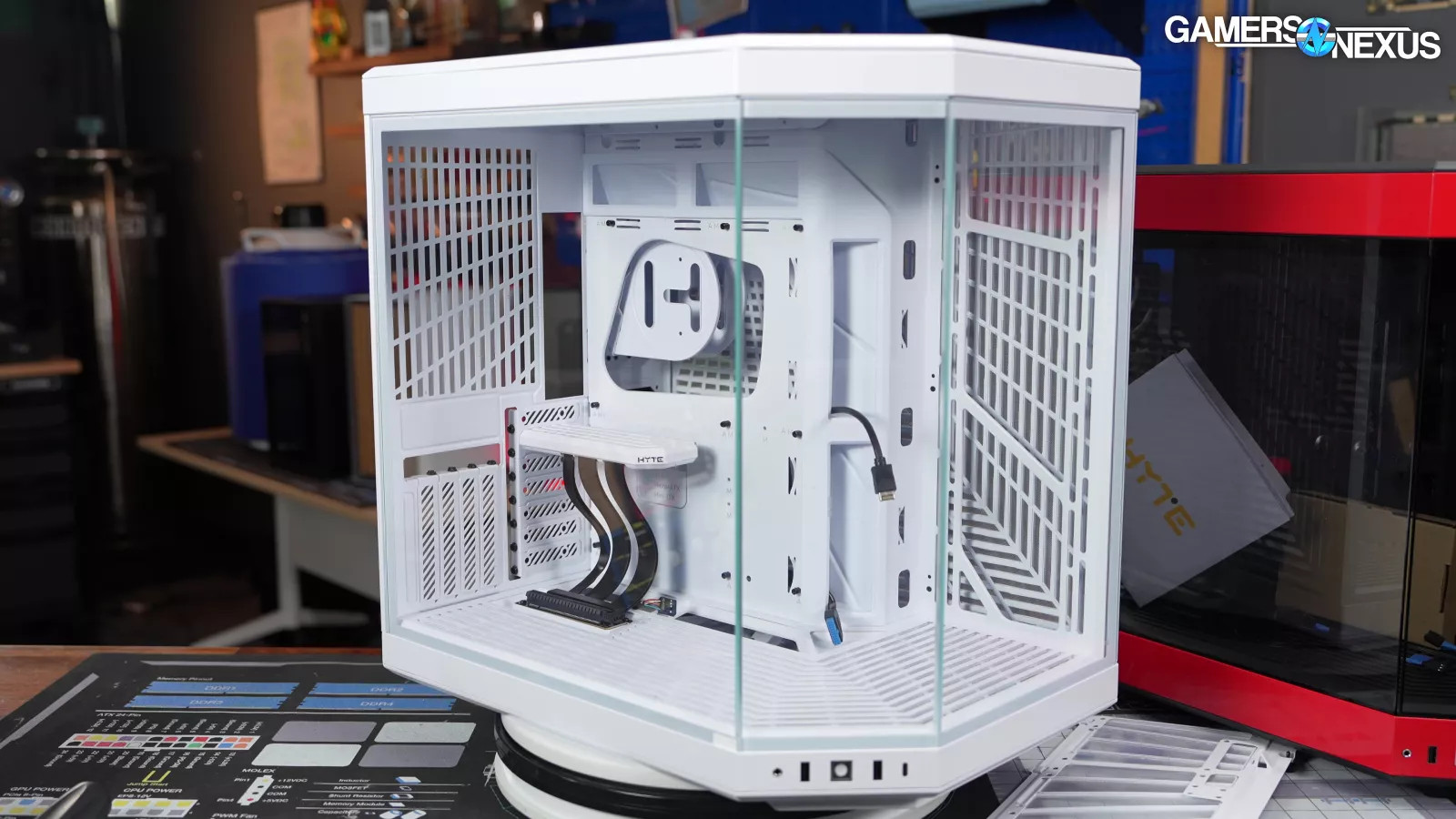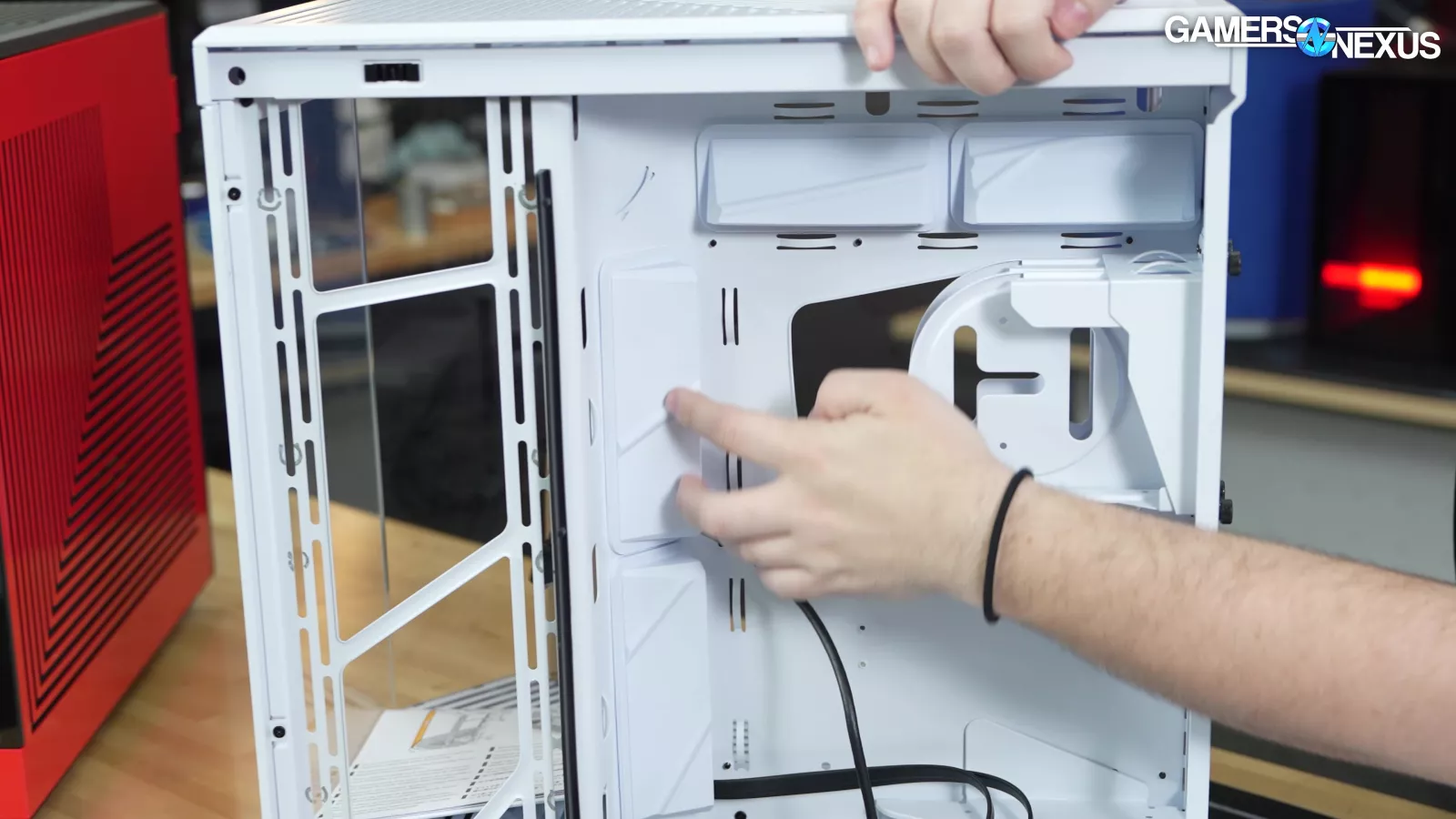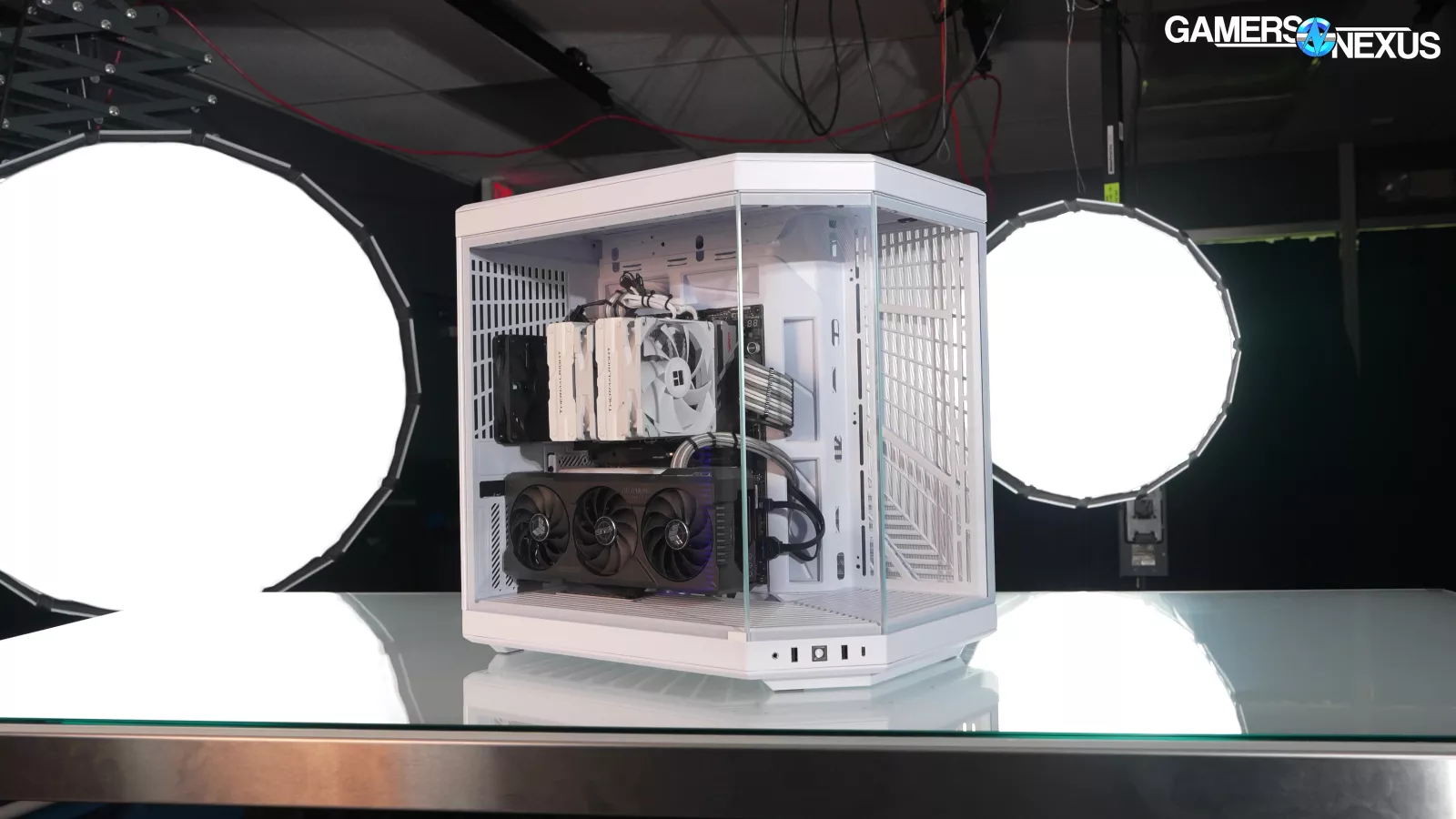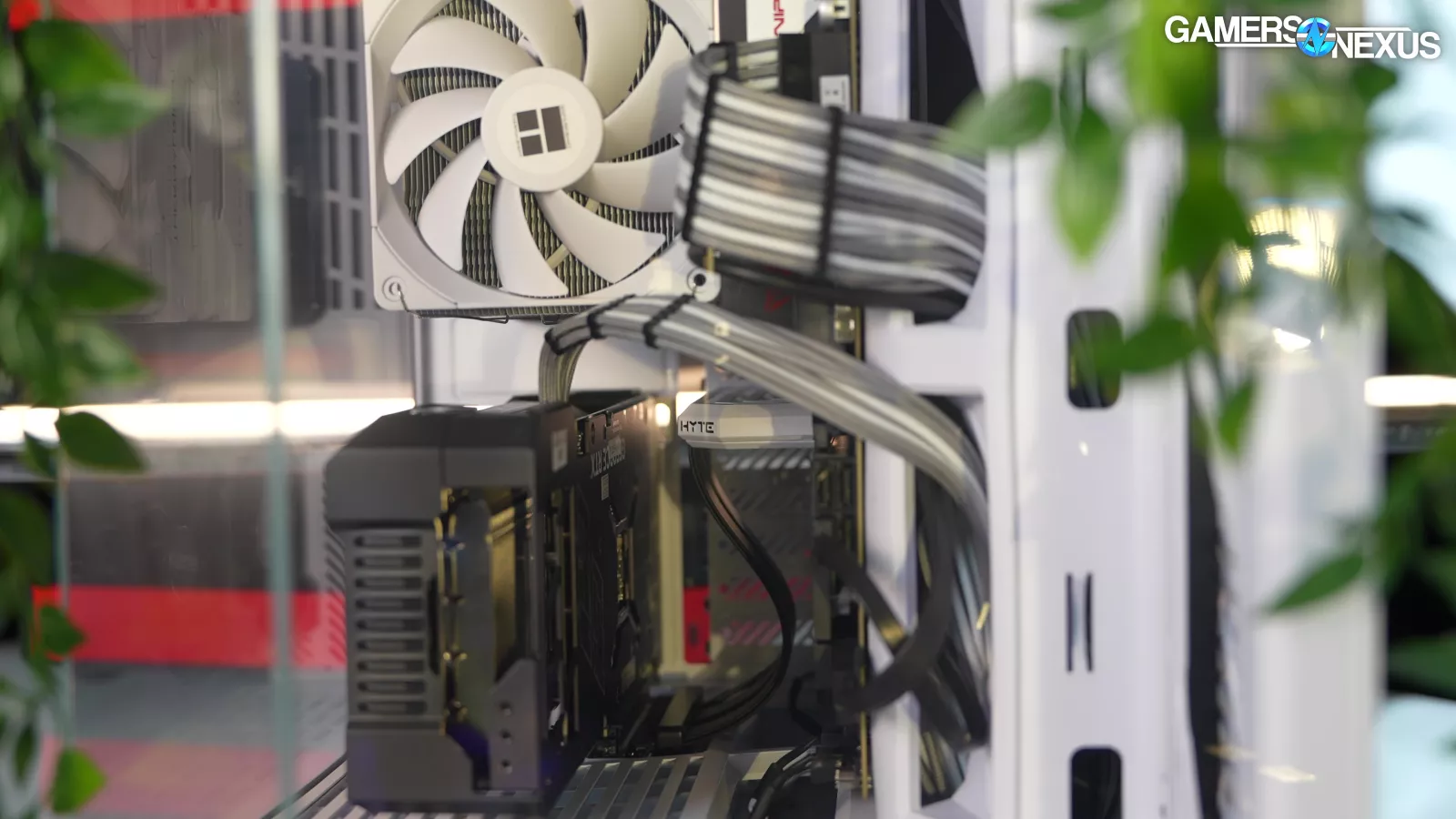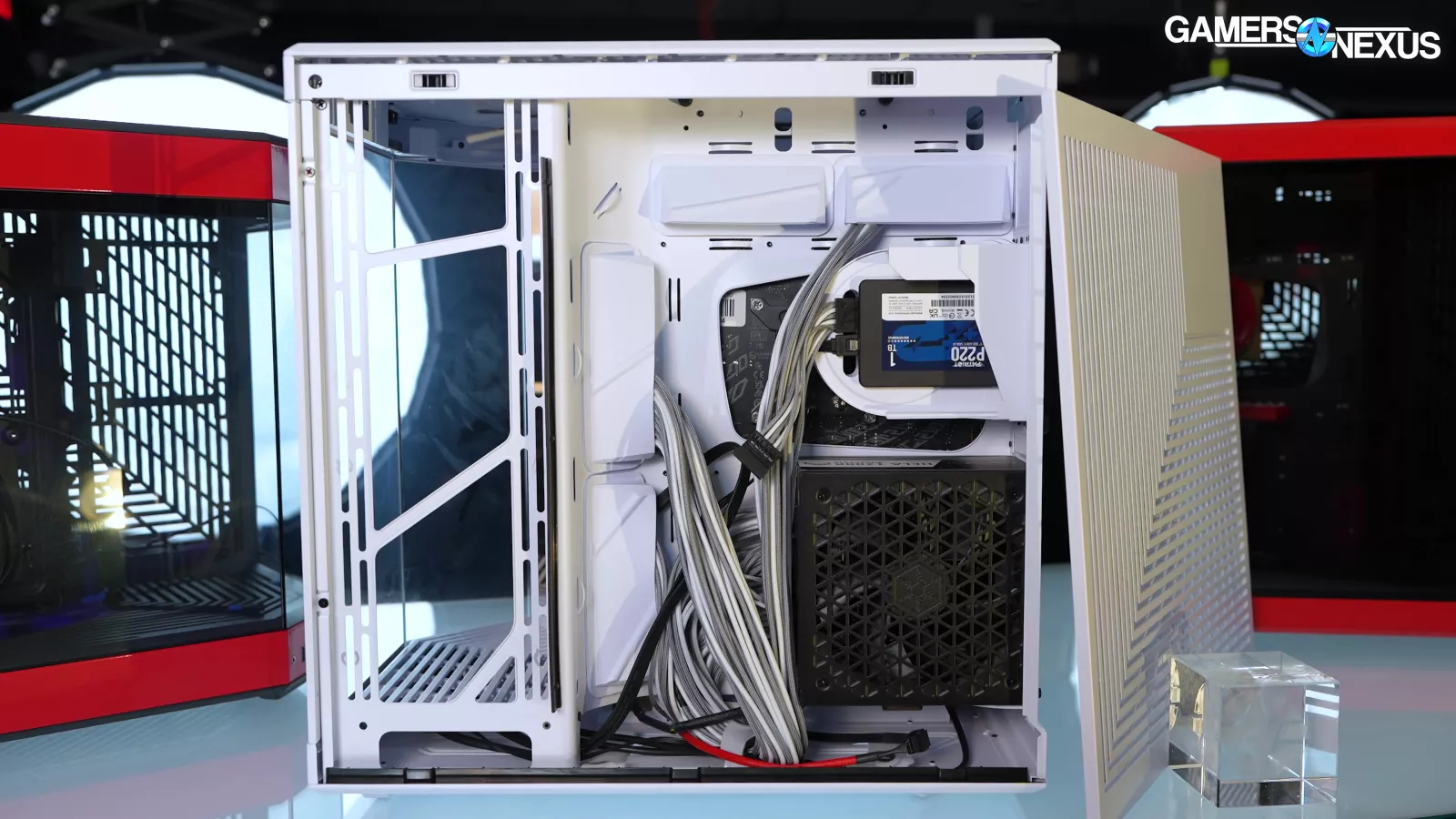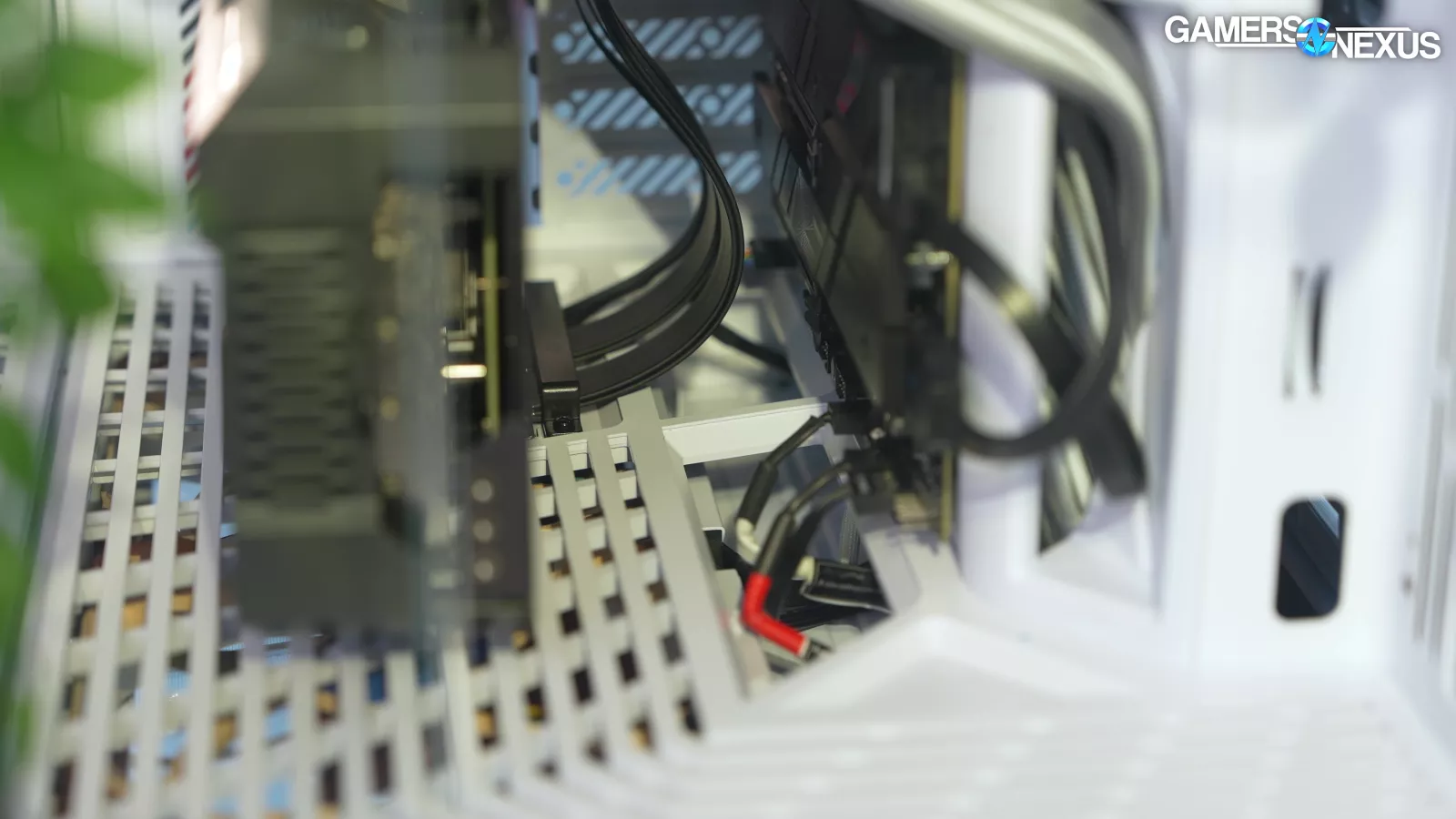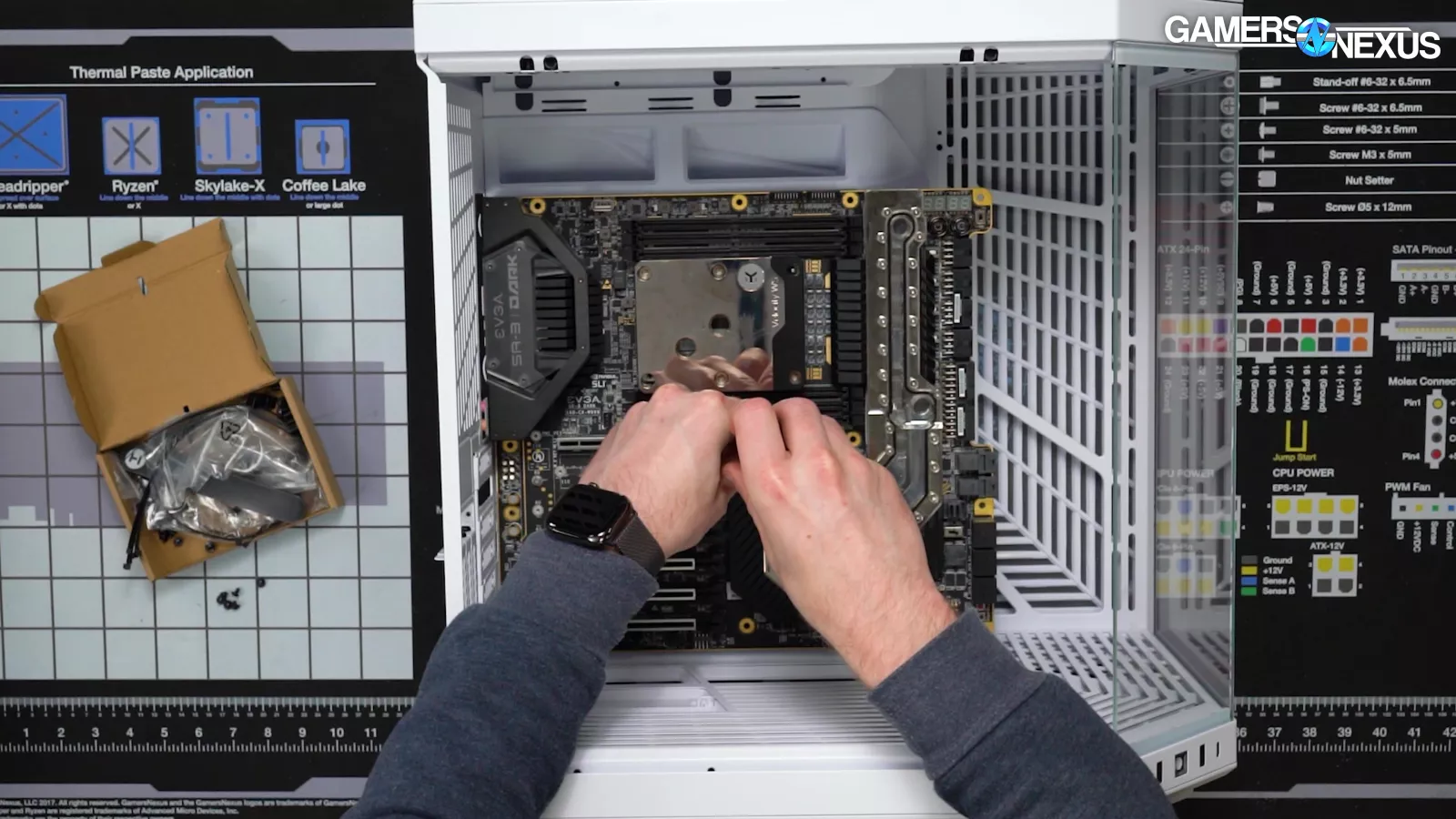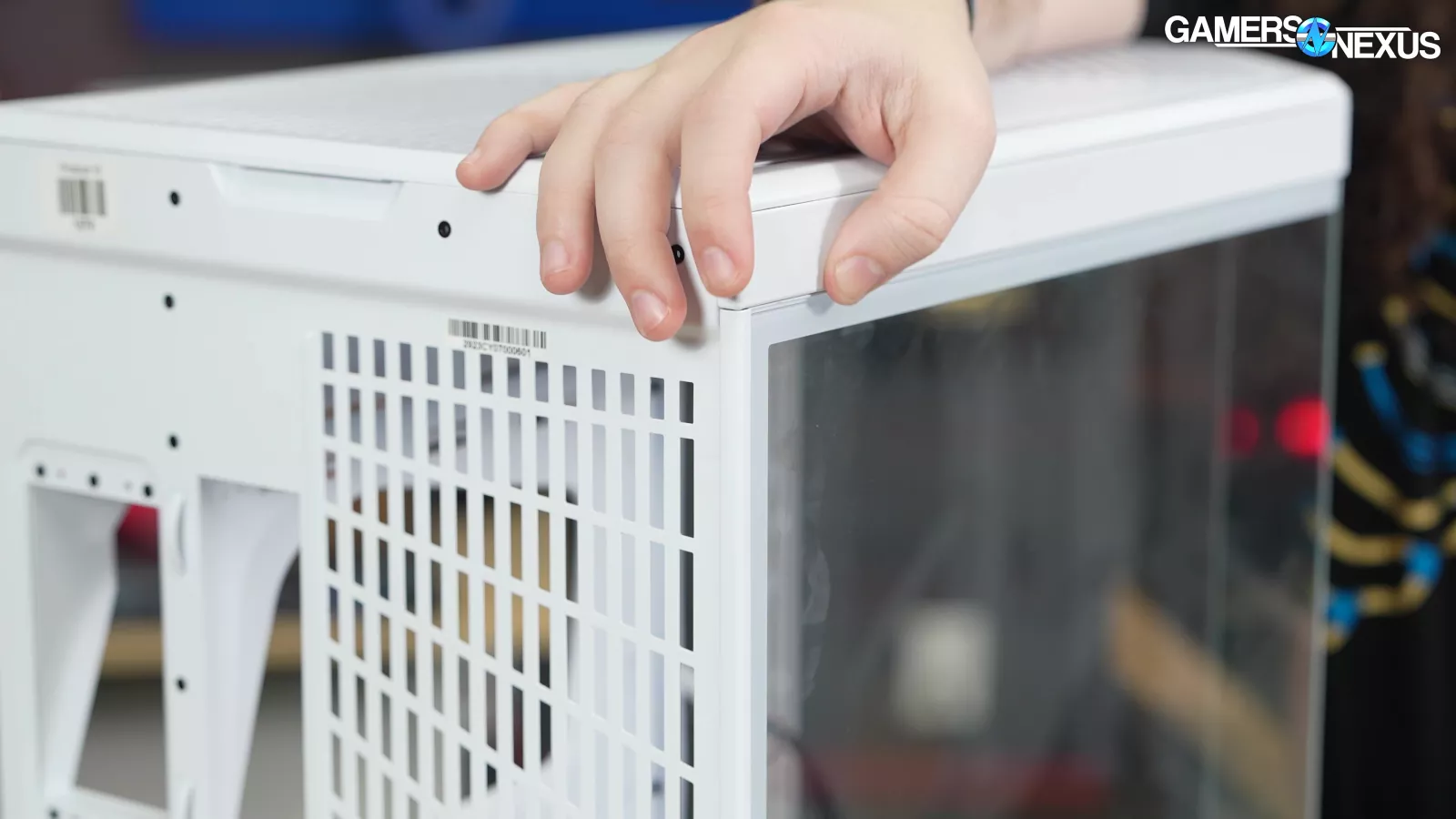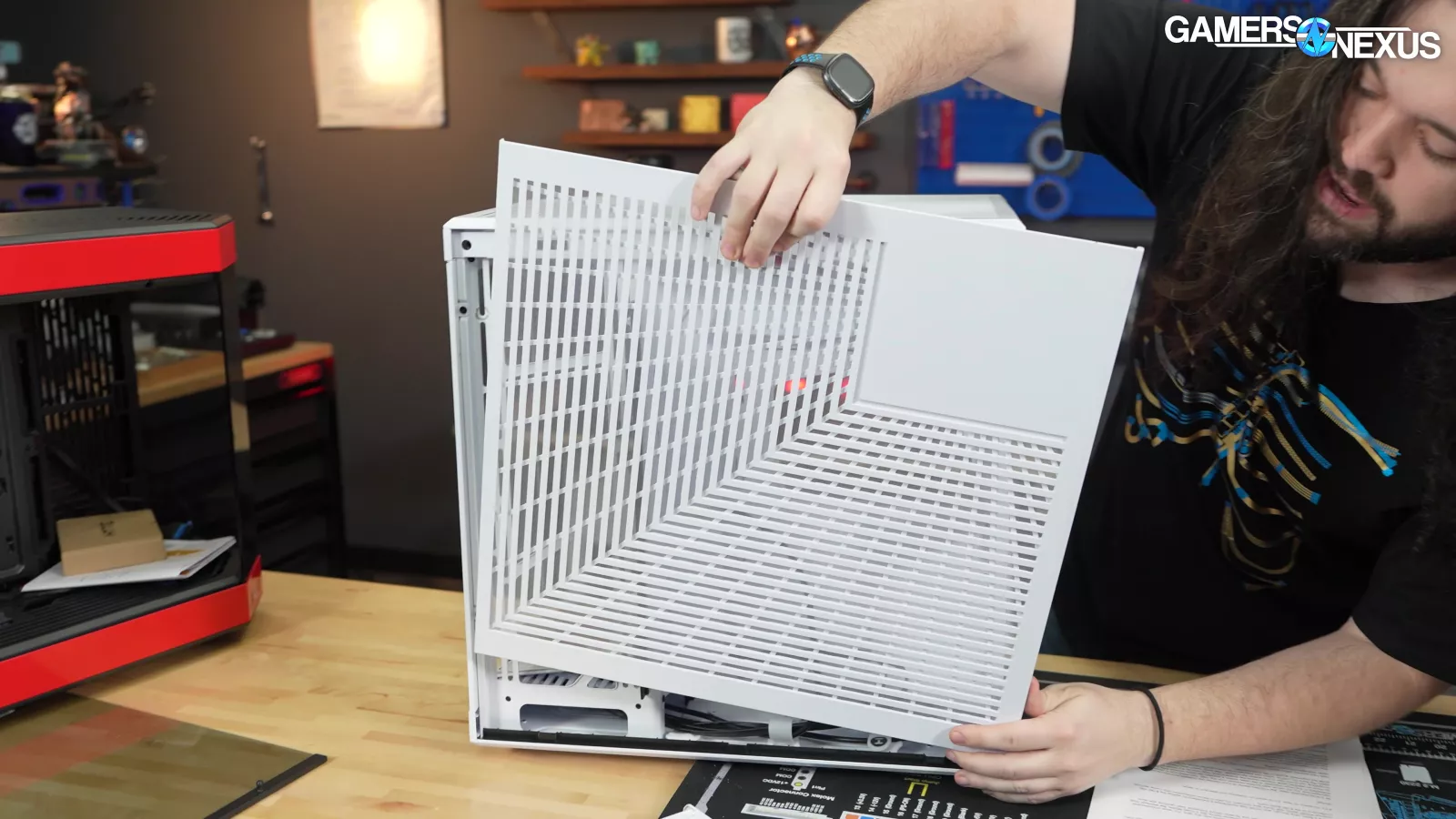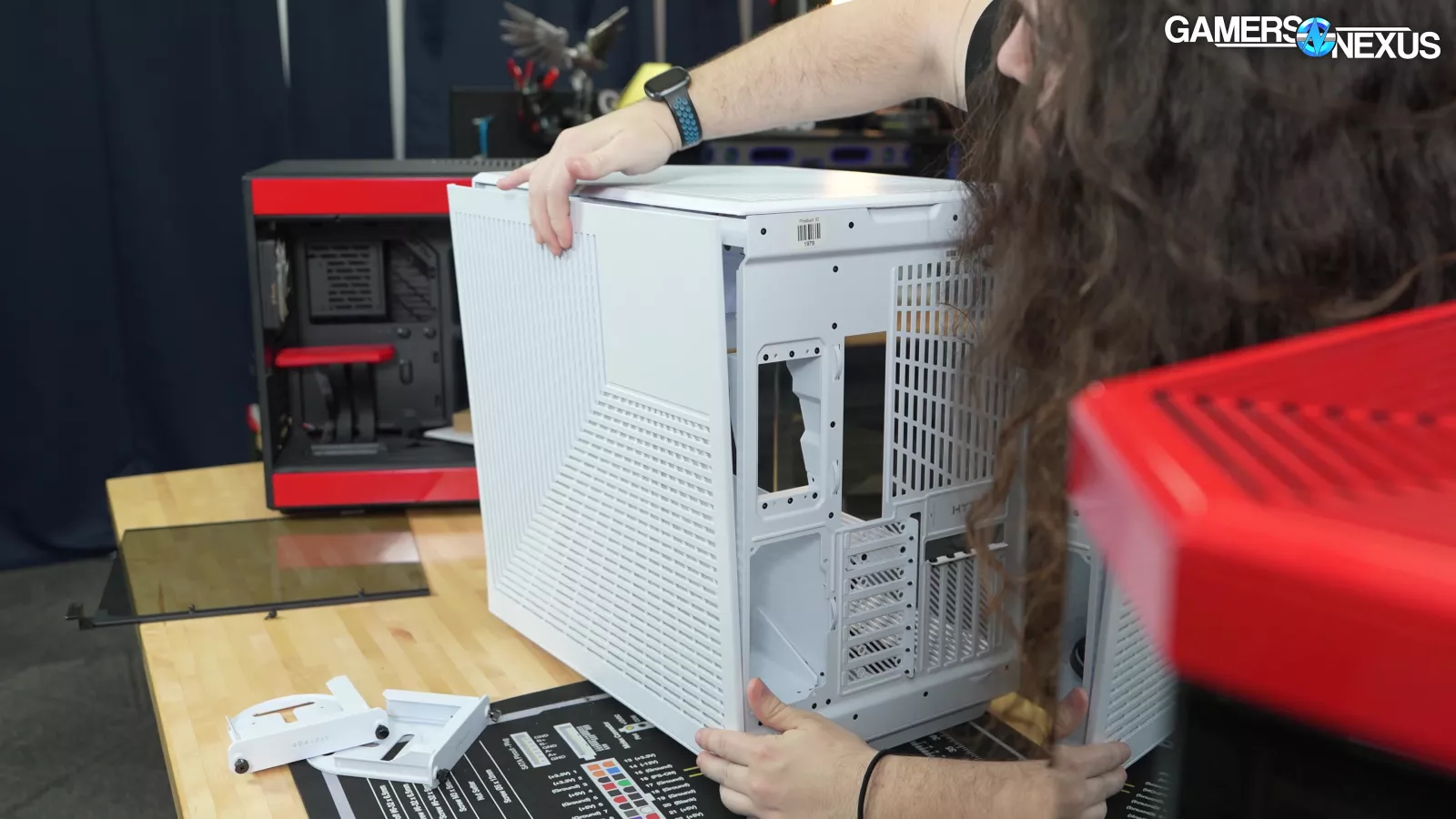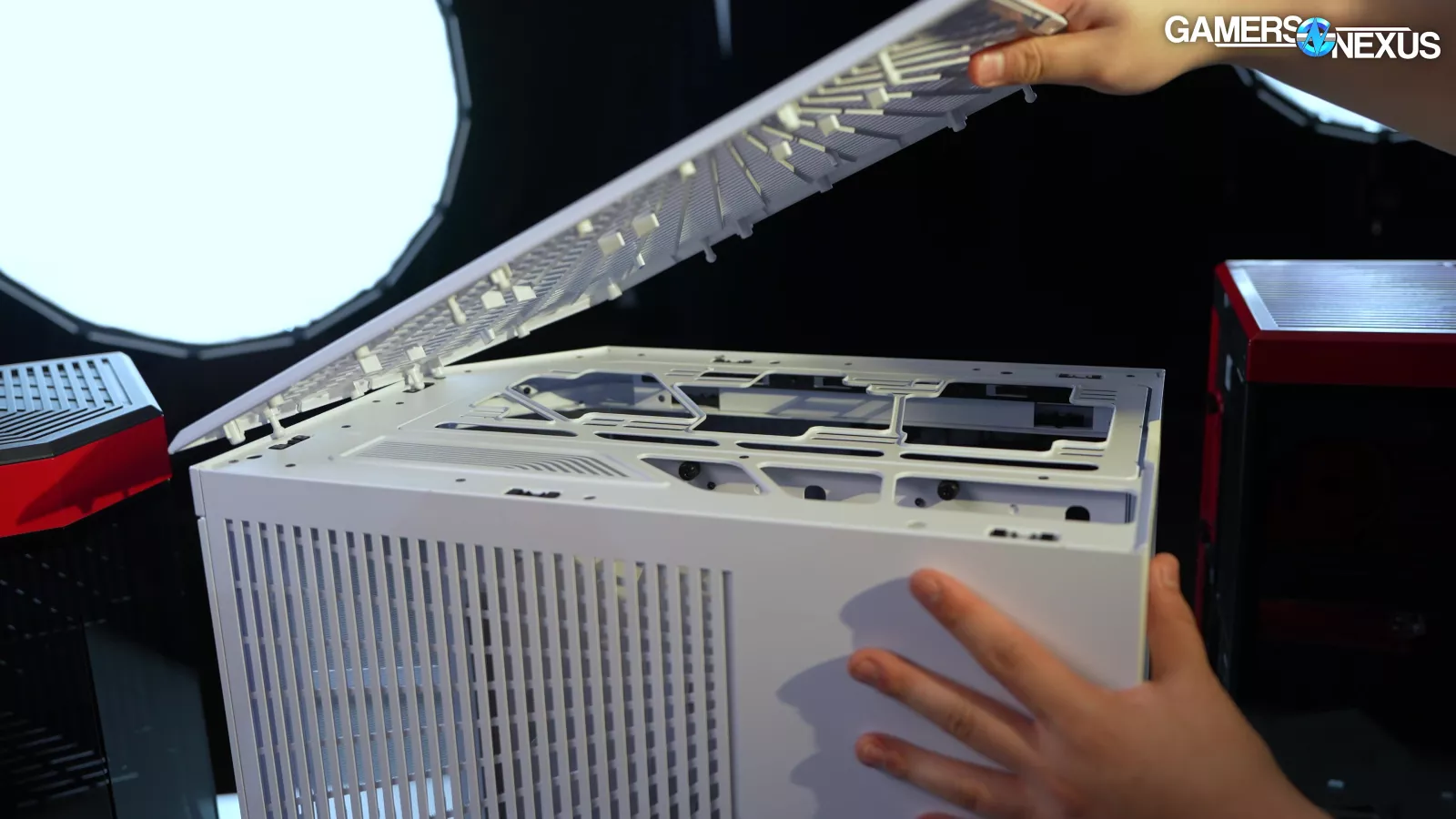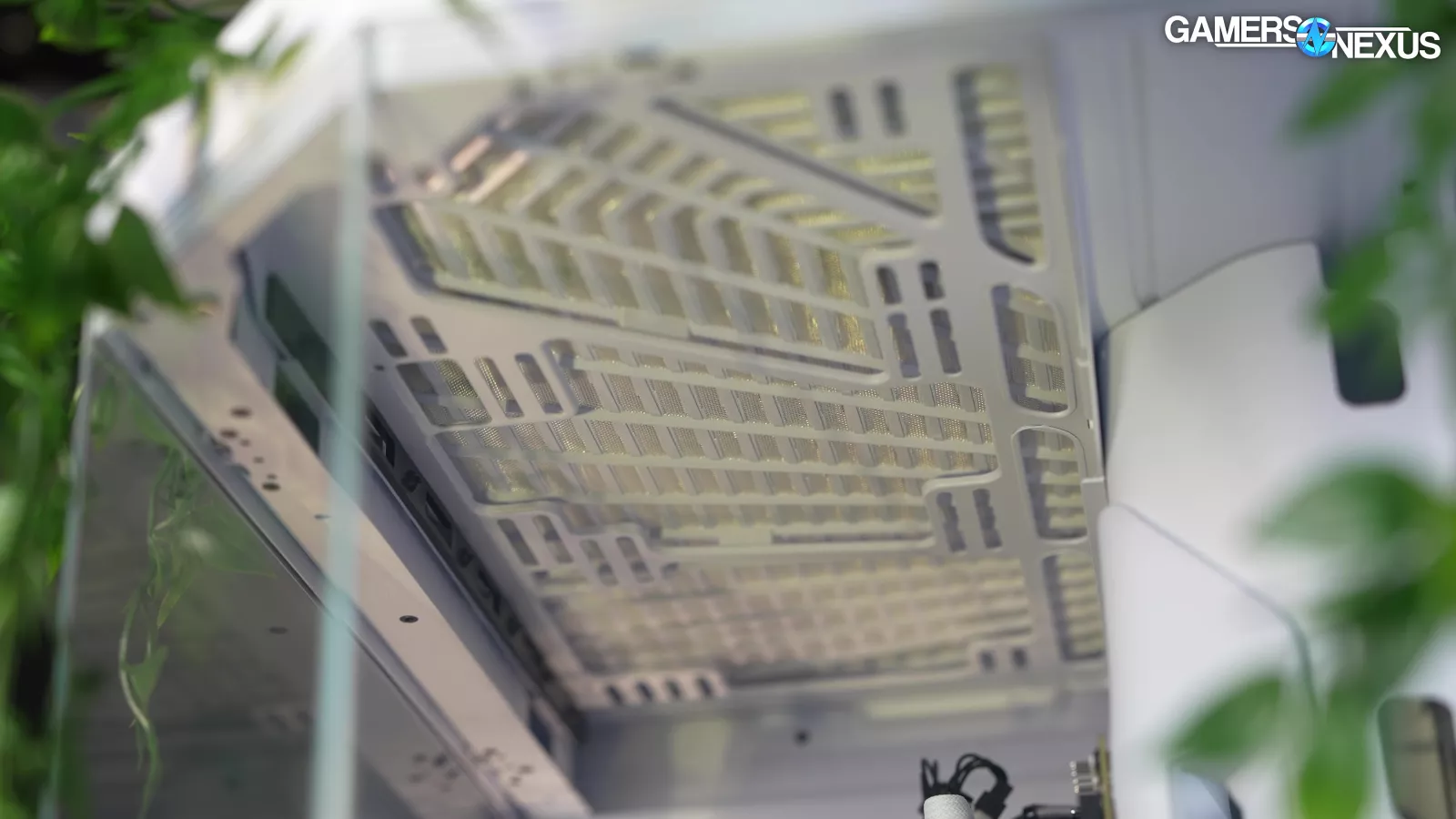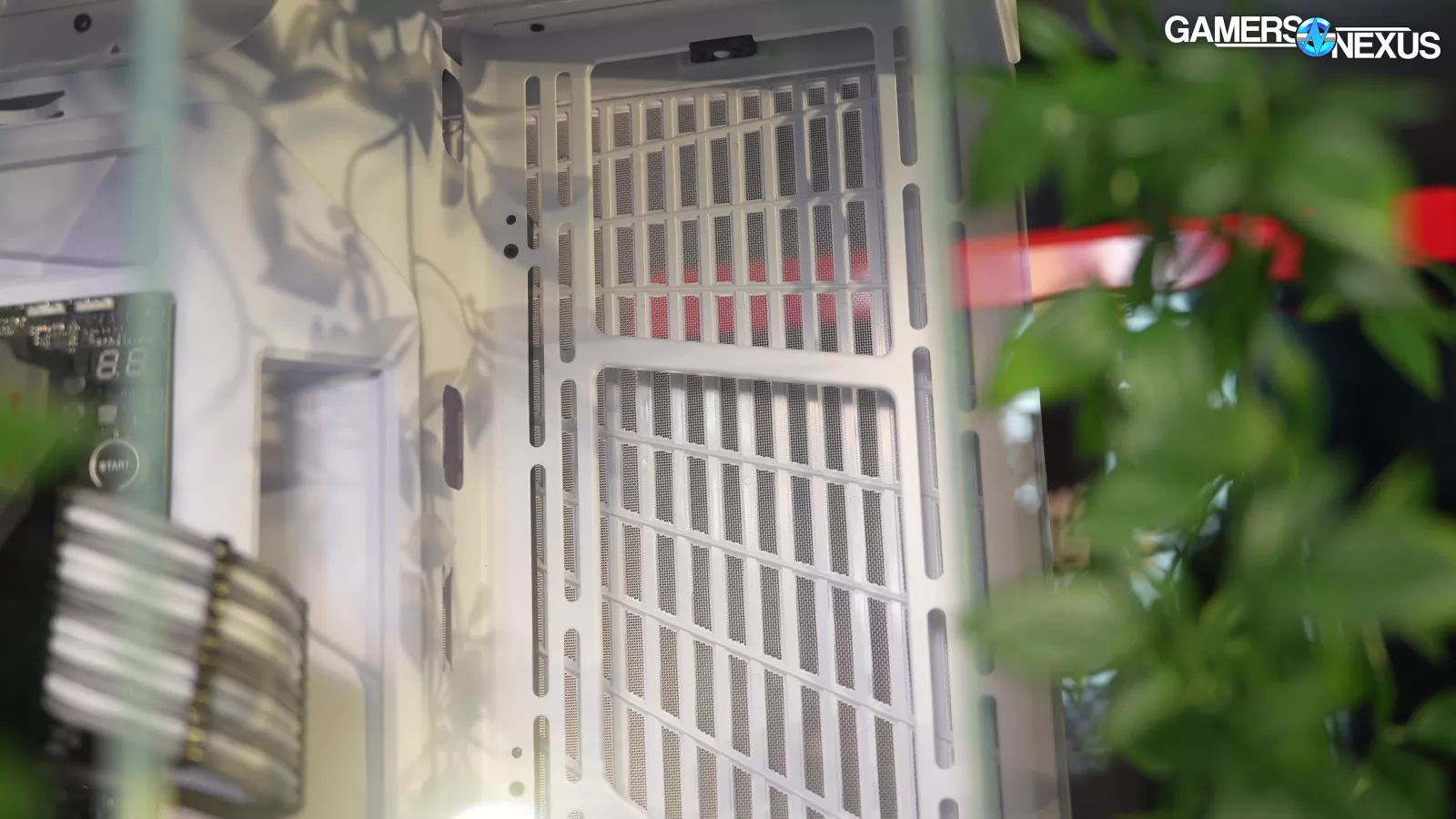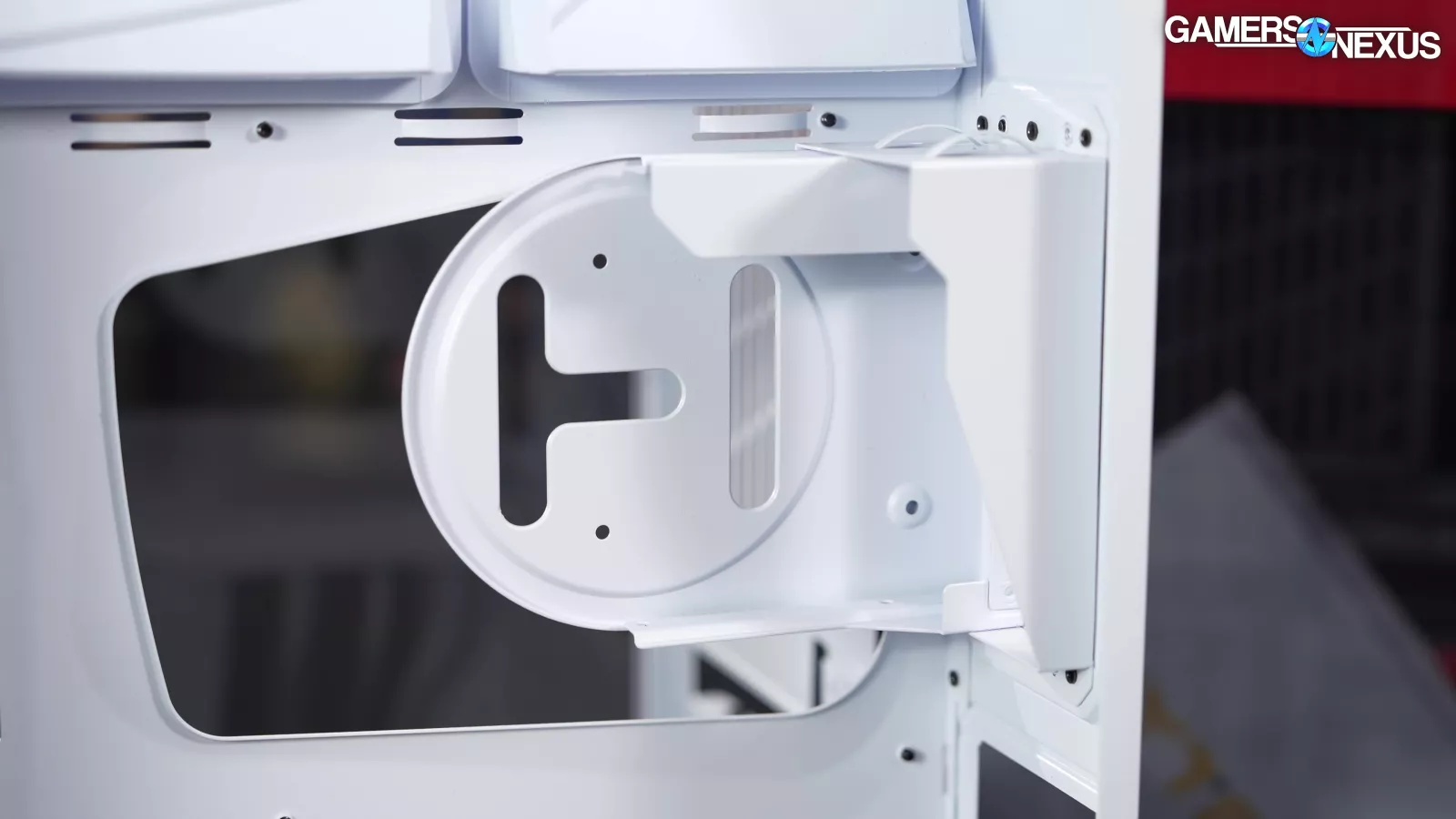
We evaluate the Hyte Y70’s features, build quality, thermals, and noise
The Highlights
- The Hyte Y70 is a larger version of the popular Y60 and fits 4-slot video cards
- At $220, the Hyte Y70 is expensive and doesn’t come with any fans
- The Y70 offers great cable management and offers a ton of attention to detail
- Original MSRP: $220
- Release Date: February 15, 2024
Table of Contents
- AutoTOC
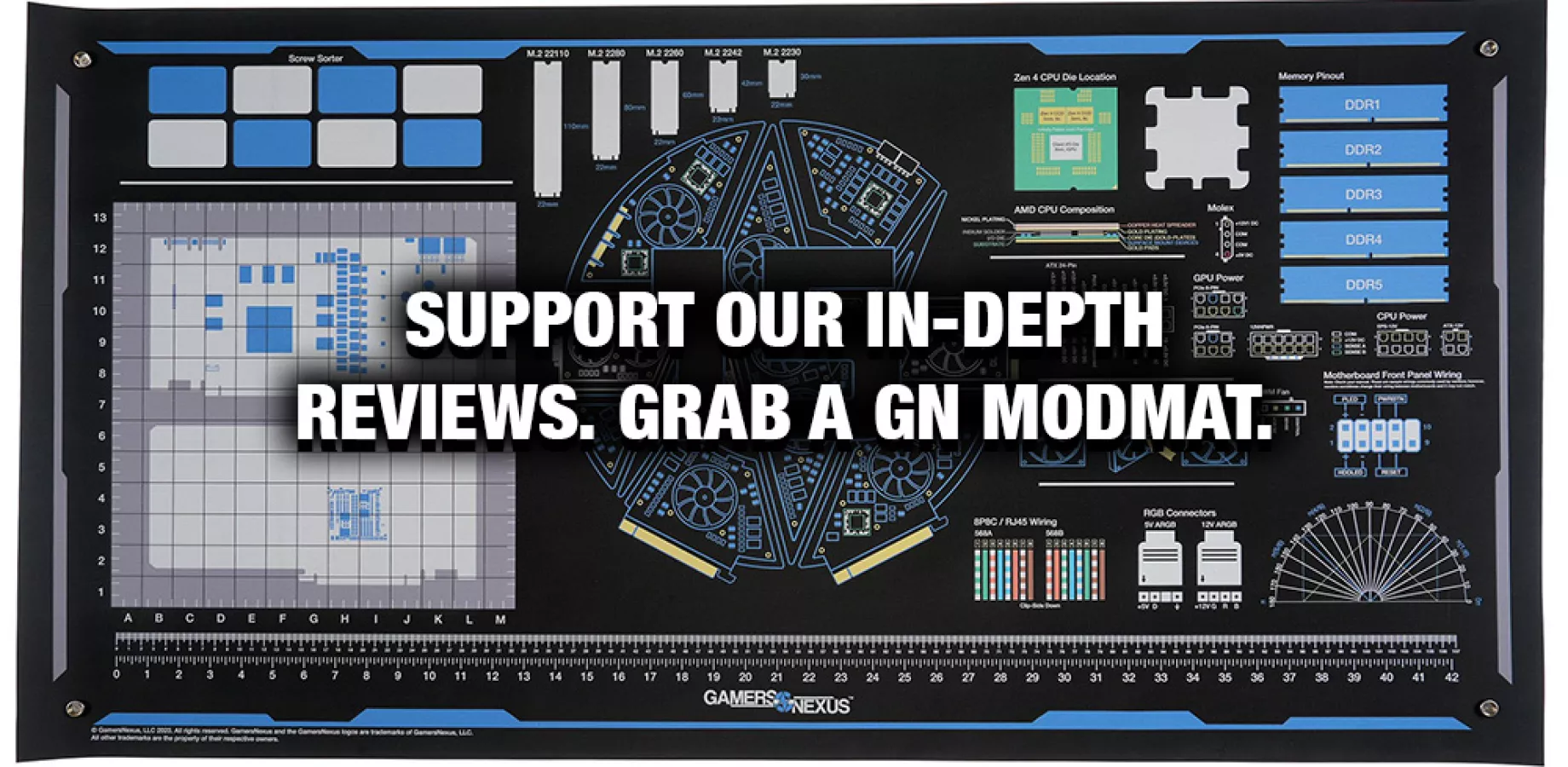
Intro
Today we’re reviewing the Hyte Y70, a case from a company so wildly popular that GameMax literally copied and pasted parts of its marketing language. This case has some of the best cable management pathways on the market right now and offers a ton of fine attention to detail, like high quality rubber grommets that form a well-managed channel between the main and secondary chambers of the case. The case also goes to great expense to integrate a panel-to-panel geometric flow dotted with Hyte logos to the mesh. And by “Hyte goes to great expense,” we mean you. You’re paying for it. The case is $220 and it doesn’t include a single fan.
Editor's note: This was originally published on May 20, 2024 as a video. This content has been adapted to written format for this article and is unchanged from the original publication.
Credits
Testing, Host, Writing
Steve Burke
Testing, Writing
Patrick Lathan
Camera, Video Editing
Vitalii Makhnovets
Web Editing
Jimmy Thang
Hyte burst into the ATX market with its wildly successful Y60, but the timing wasn’t great: The company began designing the case before NVIDIA’s advent of 4-slot GPUs, mitigating performance of larger GPUs to OK at best in the Y60. In came the Hyte Y70 Touch, which replaced an entire glass panel with an LCD. The Y70 Touch costs the same as a CPU made in a $20 billion fab at $360, which is insane to think about, and we never would have expected that it would become so popular that Hyte would deplete the supply of those LCDs before demand waned. In fact, Hyte is bringing an entirely new factory online exclusively for that screen.
It’s clear that the industry’s mainstream growth has created a huge market for looks-oriented builds. That’s fine, but we’re here to evaluate the function. Today, we’re reviewing Hyte’s holdover model, the Y70 non-touch, that it introduced because it couldn’t make screens fast enough.
We’ve had a mixed history with Hyte. First of all, its parent company is iBUYPOWER…but that’s why it’s so much more impressive that Hyte doesn’t suck.
Hyte has made it exceptionally clear that it behaves like an entirely different entity, and we can tell you first-hand that’s definitely the case. It has iBUYPOWER funding, but it’s driven by engineers who seem to have an understanding of DIY PCs.
Our first review of a Hyte product concluded with “we don’t hate it.” That was the Revolt 3 ITX case. It wasn’t particularly noteworthy and felt like a remnant of its parent company iBUYPOWER. Next, we liked the Y60 (watch our review) and thought it was a creative take on a dual-chamber design that meaningfully deviated from the trend of O11-like cases, despite middling thermal performance. Then we reviewed the Y40 and felt like Hyte had removed all the best parts of the Y60 while also worsening the thermal performance, leaving us with a disappointing follow-up. We had absolutely no reason to recommend the Y40 and favored its many competitors over the case.
The HYTE Y70 Touch launched late last year in the midst of our case review hiatus and the no-screen Y70 is relatively new. It's a scaled-up version of the Y60 with the same signature chopped-off corner and shrouded riser cable. The Touch has the addition of an 1100x3840 touch screen, which Hyte misleadingly describes as “4K” despite being almost literally HALF of the actual pixels of what everyone understands to be 4K. 3840x1100 is closer to 1440p than it is to 4K. It’s not great to start marketing with what effectively amounts to a lie.
HYTE Y70 Specs (versus HYTE Y60)
| HYTE Y70 | HYTE Y60 | |
| Type | Dual Chamber Mid-Tower ATX Case | Dual Chamber Mid-Tower ATX Case |
| Exterior Dimensions | 470 x 320 x 470 mm | 456mm (L) x 285mm (W) x 462mm (H) |
| Volume (L) | 70.7 | 60L |
| Motherboard Sizes | ITX, mATX, ATX, EATX | EATX, ATX, mATX, ITX |
| Expansion Slots | 7 half + 4 full height | 3 + 7 half-height |
| Riser Cable Included | Yes, PCIE 4.0 x 16 | 4.0 x 16 (included) |
| I/O | 1x USB-C 3.2 Gen 2, 2x USB-A 3.2 Gen 1, 1x 3.5mm Audio/Mic Combo Jack | 2 Front USB 3.0, 1 Front USB 3.2 Gen 2 Type-C, 1 Audio/Mic Jack |
| Dust Filters | Top, Side, Bottom | Bottom, Side, Top |
| Top Fans | 3x 120 mm / 2x 140 mm | 3x 120mm |
| Top Radiator | 120-360, 140-280 @ 68 mm thick | 120, 240, 360mm up to 30mm thick |
| Rear Fans | 1x 120/140 mm | 1x 120mm (1x 120mm, 1300 RPM included) |
| Rear Radiator | 1x 120/140 mm | 120mm |
| Side Fans | 3x 120 mm / 2x 140 mm | 2x 120/140mm |
| Side Radiator | 120-360, 140-280 @ 125 mm thick | 120, 140, 240, 280mm up to 150mm thick |
| Bottom Fans | 3x 120 mm / 2x 140 mm @ 32 mm thick | 2x 120mm/140mm (2x 120mm, 1300 RPM included) |
| Max Video Card Length | 422 mm | 375mm length |
| Max Video Card Thickness | 105 mm ["90mm optimal"] | 75mm width (60mm or less recommended for best cooling) |
| Max CPU Cooler Height | 180 mm | 160mm (When using an air cooler rather than liquid cooler, HYTE recommends the installation of 2 additional intake fans (not included) on the side mount of the Y60 for optimal airflow.) |
| Max PSU Length | 235 mm | ATX up to 235mm in length |
| Storage | 2x 3.5" HDD or 4x 2.5" SSD | 2x 3.5" HDD or 4x 2.5" SSD |
| Warranty | 3 Years | [3 Years https://hyte.com/warranty-service] |
Specs copied from manufacturer materials, please read review for our own measurements and opinions
HYTE Y70 Build
Let’s get into the actual build quality.
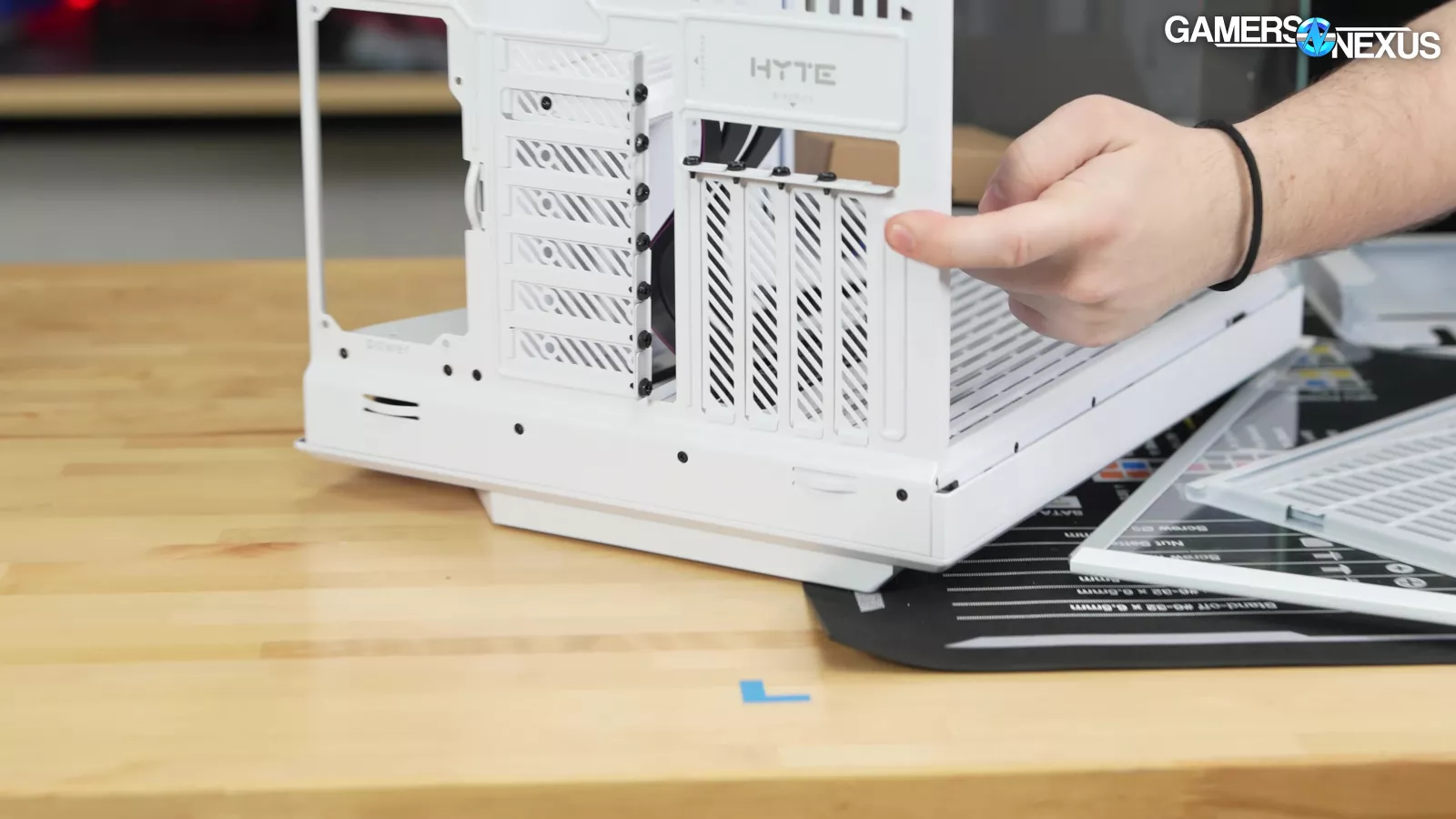
The Y70 differentiates itself from the Y60 with its four vertical PCIe slots, plus some extra. The Y60 has a strict three slot limit. That's a massive GPU compatibility improvement that’ll improve thermals.
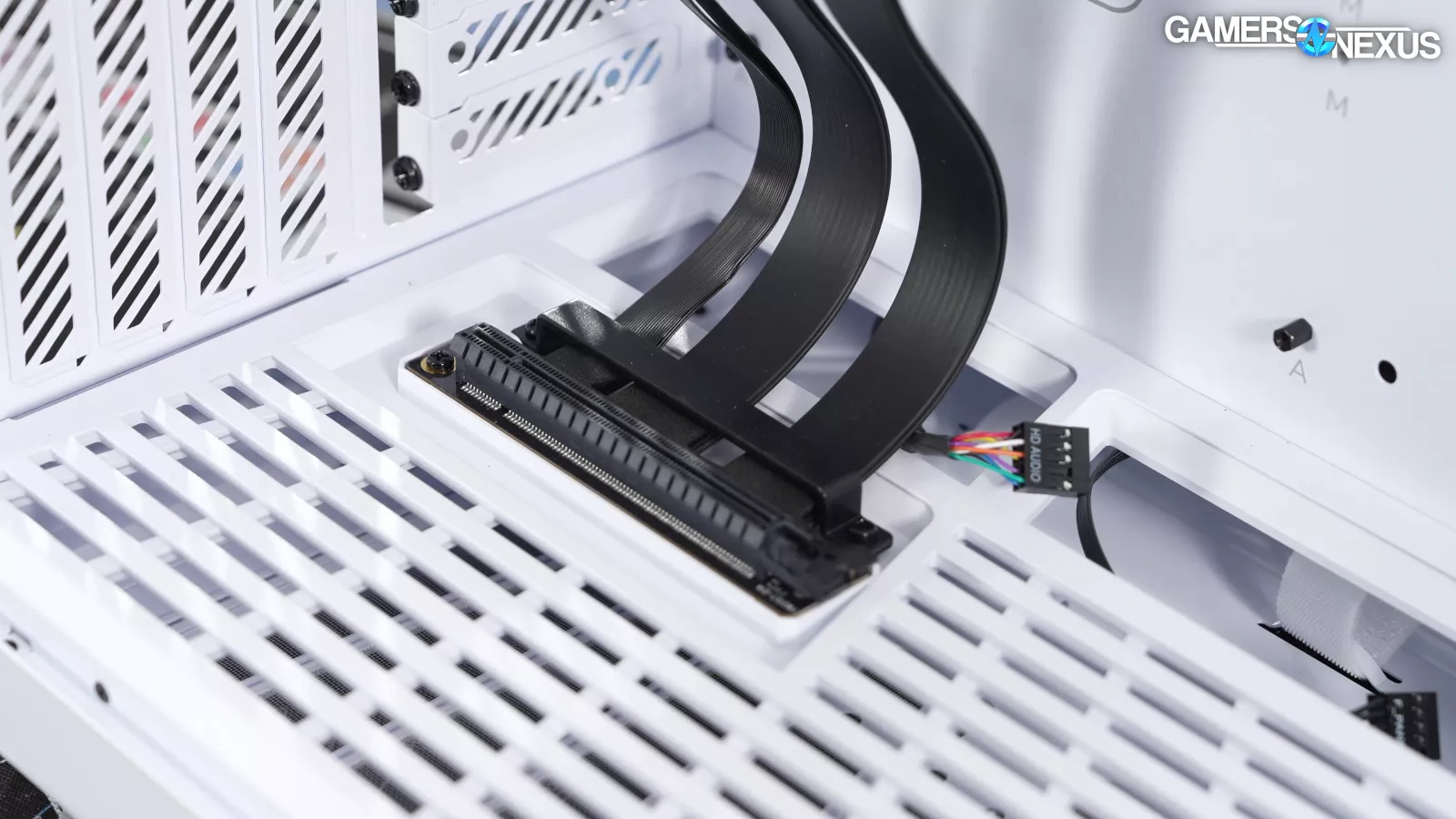
The GPU is forced vertical with a built-in riser. Horizontal GPUs could be supported if Hyte went the route of others and added a rotating bracket like the Fractal Design Flex 2, but that’d add cost. Hyte is also going for the guided build approach.
In the Y60, the front of the case is wasted space without installing a side-mounted radiator or fans, and that remains true with the larger Y70. Only the largest GPUs extend far enough to use this area.
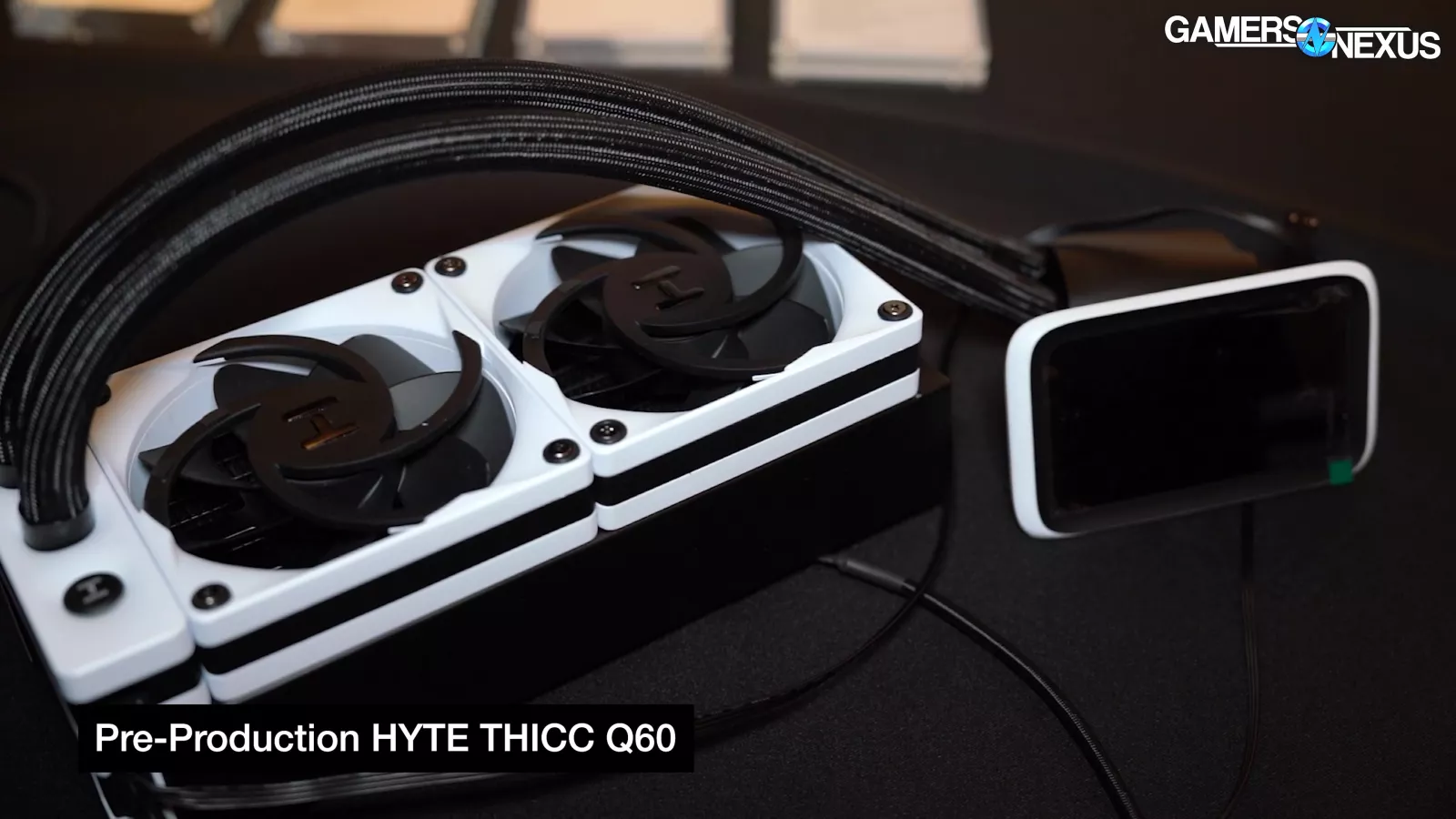
That’s where the monster that is the Thicc Q60 comes in. It’s about 80mm of fan and radiator that Hyte built to occupy this space. Without going custom loop, to our knowledge, this is the only way to get such a fat combination of cooling.
But that’s not part of this review. The Y70 doesn't come with any fans. For large dual-chamber cases, that’s not unusual: the Lian Li O11 Dynamic (watch our review) family, the Corsair 6500s, the Montech King 95, and the Antec C8 all have at least one fanless variant alongside their versions with fans.
This is a $220 case though, and HYTE has established a precedent by selling the $180 Y60 (original MSRP $200) with three fans included. It’s also in fierce competition with some serious contenders at the $180-$200 mark.
If it’s not spent on fans, it’ll be spent on materials and attention to detail.
As a dual chamber case, the Y70 has plenty of room behind the motherboard tray for cable management, but it's not an appreciable increase over the Y60. The extra size is more noticeable in the main chamber of the case, where it enables the extra vertical GPU slot as well as more accessible cable cutouts below the motherboard. The cutouts are larger and completely out of the way of the bottom fan mounts. The extra space also makes it easier to reach the front I/O cables, which are trapped in an inaccessible corner of the Y60. This is a small but important quality of life improvement.
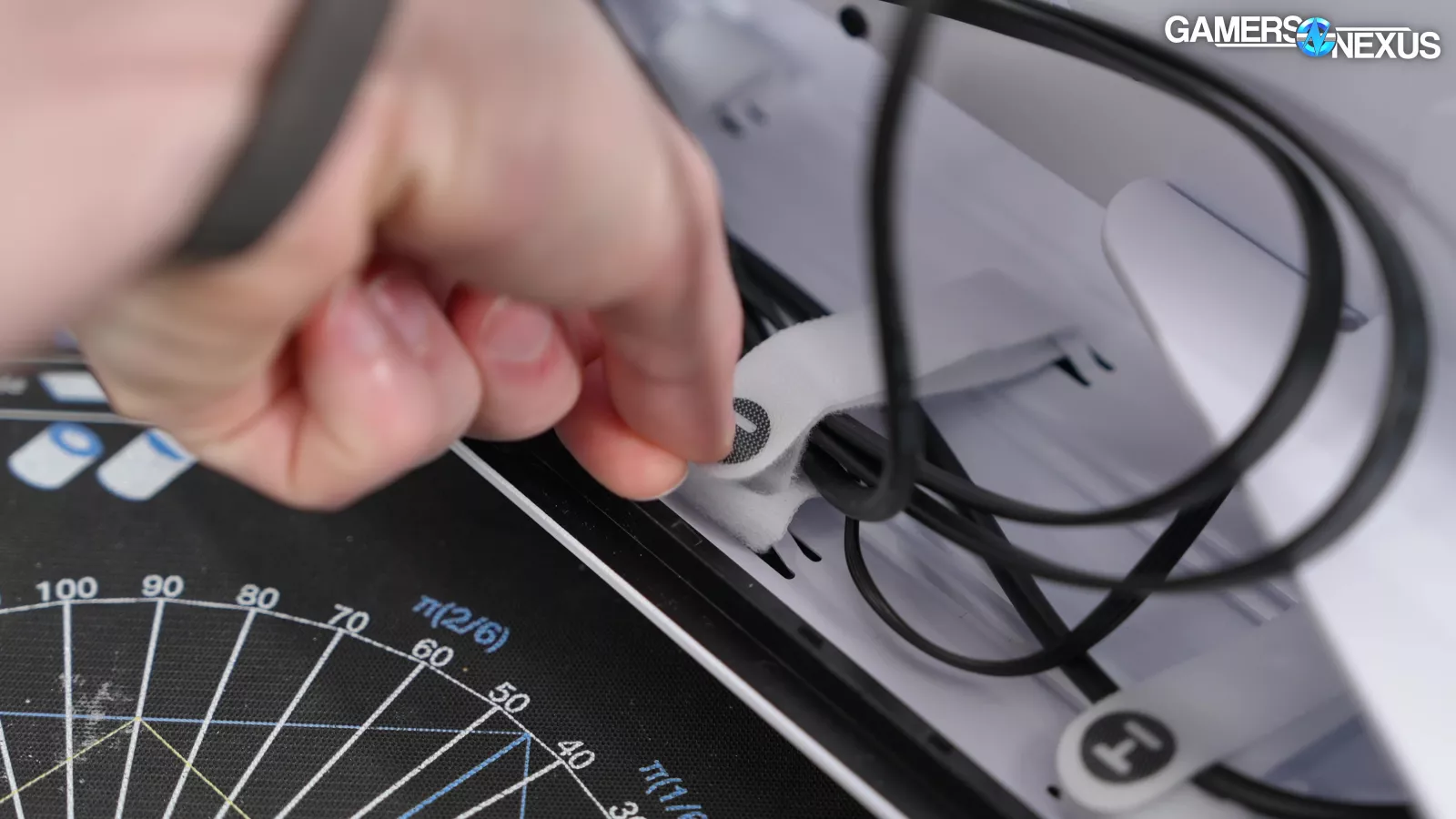
Hyte has several velcro straps preinstalled in the Y70, aiding what we think is overall impressive cable management and routing.
The Y70 claims support for EATX boards, but like the Y60 before it, this just means that there are no hard obstacles to putting an EATX board in the case. The motherboard tray is sized for ATX boards with ATX standoffs, and anything beyond ATX will overhang so it’s a bit of a stretch to say it’s compatible. The tray is bordered by elaborately molded single rubber pieces that cover all of the cable cutouts on the top and front edges of the board, and the rubber is perfectly sized to outline an ATX board. The attention to detail on this piece is great as long as it doesn’t sag or discolor with age.
The side panels of the Y70 snap into place and can't be screwed down, as opposed to the Y60, which has thumb screws that hold both side panels in place. On the positive side, the snap is resilient and extremely easy to use; however, we’d prefer to have the option to screw panels down, which is how the front panel is attached.
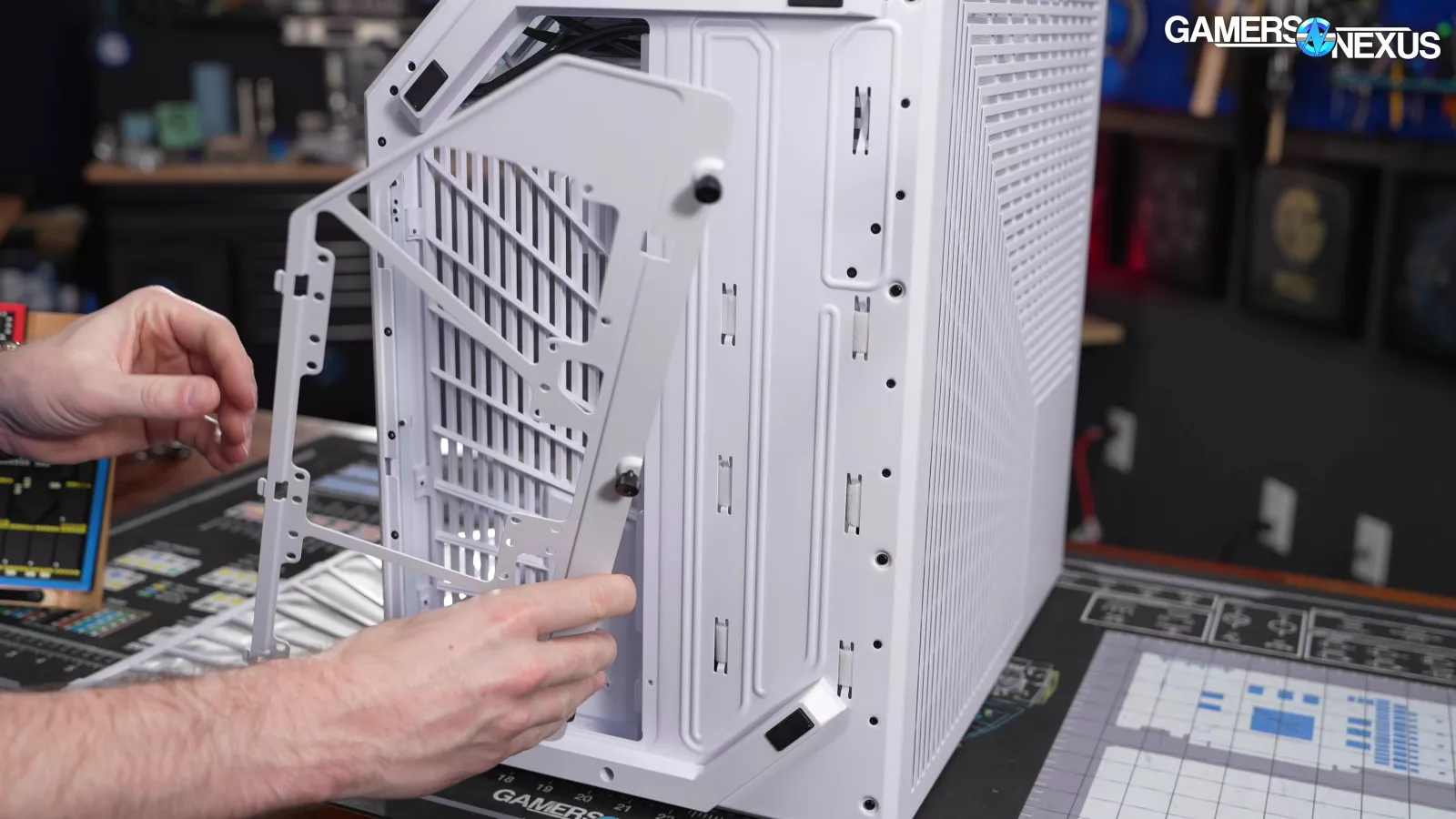
The bottom fan mount of the Y70 is an improvement for the most part, with a fan tray that's removable from the exterior of the case and can use standard fan screws rather than the special radiator screws included with the Y60. Make sure the screw heads are flat, though, or they'll bend the bottom filter.
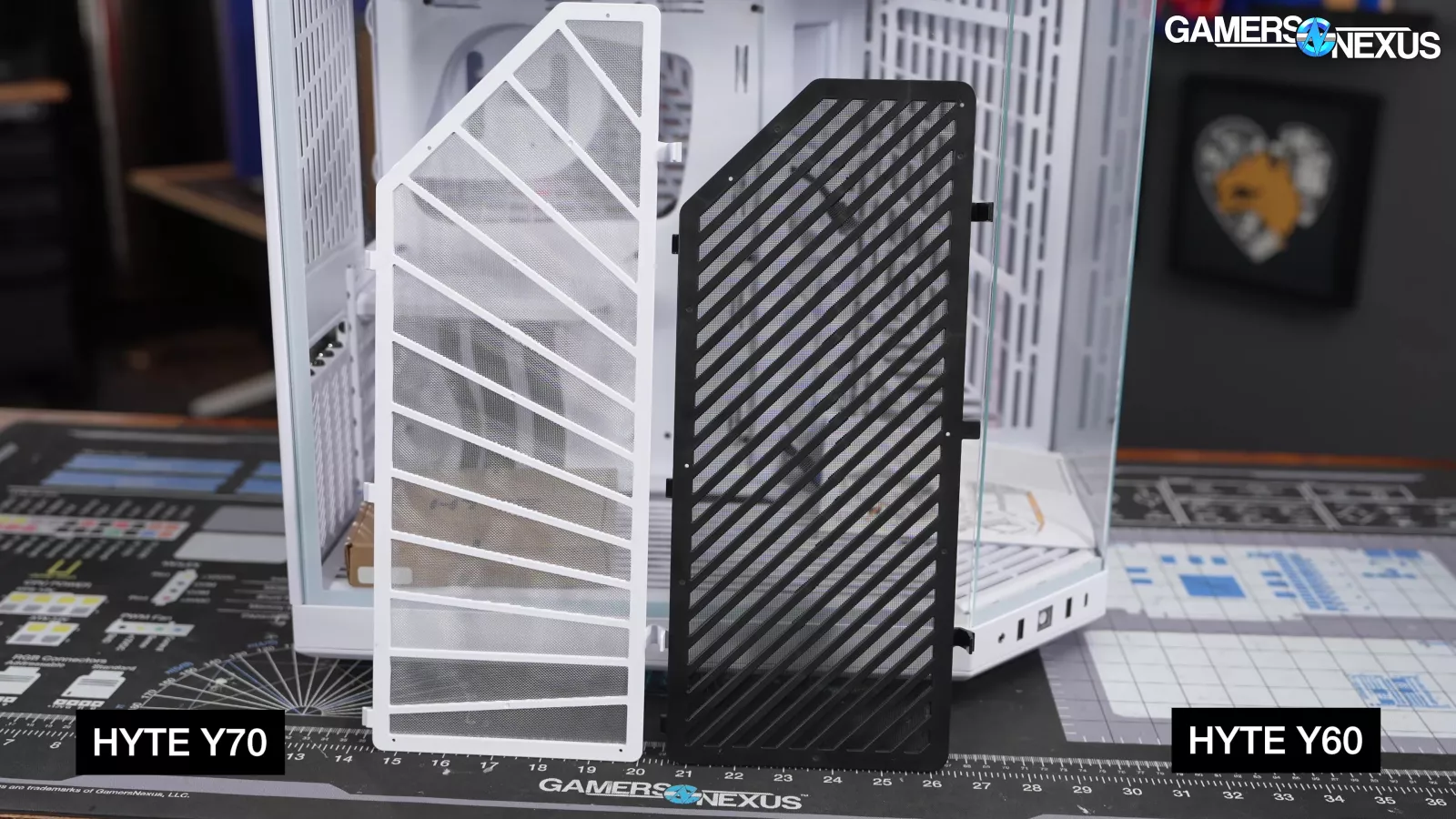
The filter is more open than the Y60's, which was restrictive enough to have a significant effect on GPU thermals in our original review -- so they’re listening. The mount is still fully enclosed on both sides, but even though that's not ideal for airflow, it effectively hides bottom fans and protects them from any loose wires. As for water cooling, the bottom mount can’t be used for radiators.
Both the side and top mounts are officially compatible with 360mm radiators at most. The top fan tray is removable with plastic springs that hold it in place firmly, and there's generous clearance on both the top and side mounts. The side mount has basically unlimited clearance depending on GPU length or up to 125mm (according to HYTE) if the GPU overlaps with the radiator area, which is a more conservative estimate than the Y60 got even though this dimension hasn't changed significantly. The top mount can fit radiators up to 68mm thick assuming standard 25mm thick fans as well.
3.5" drive support has been slowly going the way of 5.25” drives, but it’s hanging in there. In this case, support is limited to the two drive sleds in the rear of the case, which can alternatively fit two 2.5" drives each for a total of four. They’ve definitely applied small touches of detail here as well, with unnecessary but appreciated shaping of the cages.
There's no vibration damping, so the mounts are better suited to SSDs. These are the only drive mounts in the case. It's true that the Y70 is geared towards showy builds that are less likely to use SATA drives, but the Y70 is an XL version of the Y60, and it'd be appropriate to use some of that extra space for storage. We had a similar criticism of the North XL versus the North.
Companies are still making big cases, but appear to be forgetting why we ever had them.
Let’s get into the testing.
Our ATX reviews are now fully operational, and this is the first full review following our North and GameMax Hype pilot reviews. This data isn’t comparable to the previous two reviews because we’ve overhauled the methodology one last time and are using a different GPU with a higher heat load.

HYTE Y70 Thermals
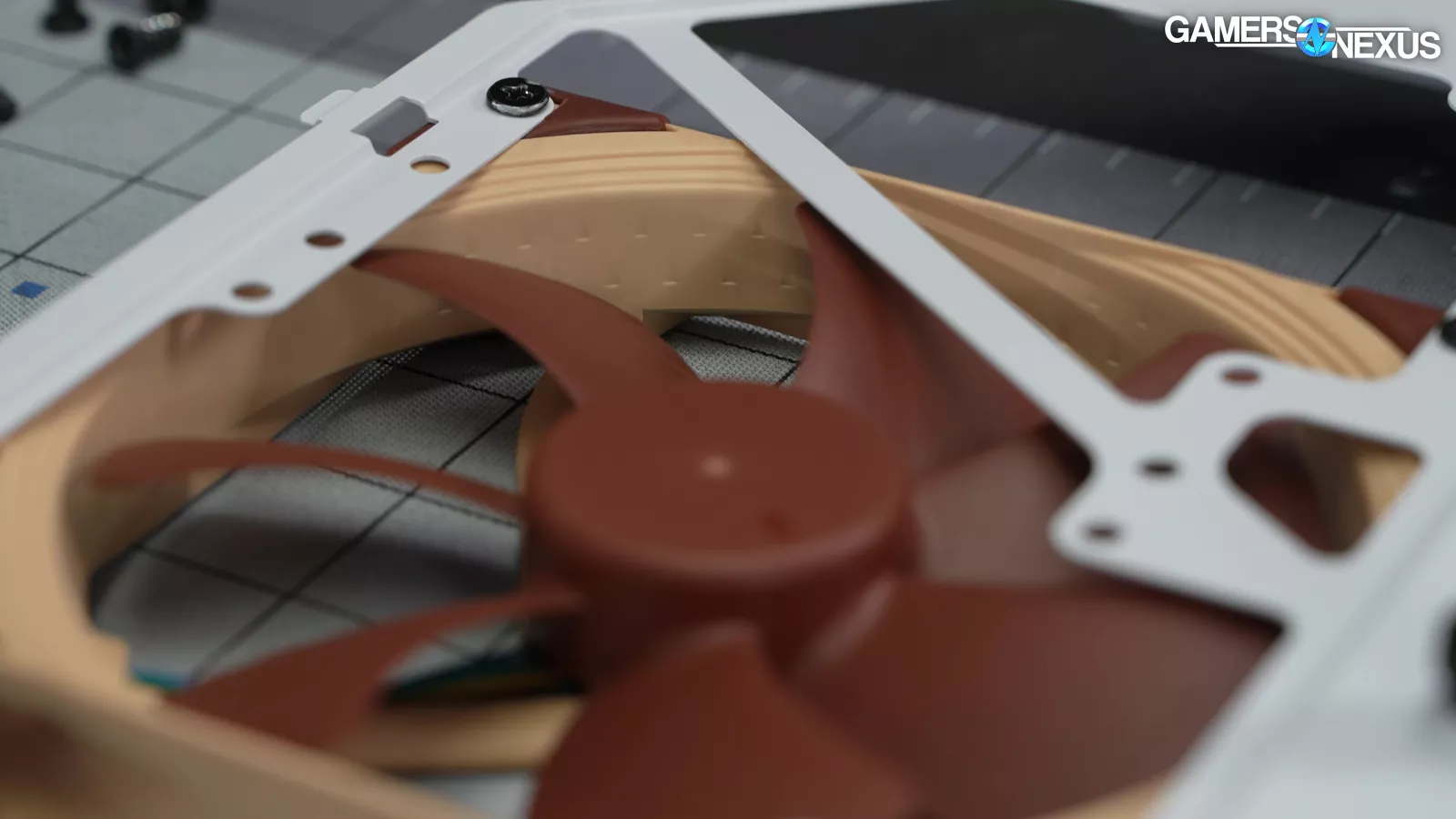
Since our last case review, we've made final changes to our new case testing platform. It's now much easier for us to get consistent data, but the changes required scrapping our existing data and starting over (again), so the numbers on these charts are different from any published previously and are not comparable. Again, since the Y70 doesn't include any stock fans, the Noctua fans from our standardized fan test were used for all tests.
CPU Full Load Thermals - Noise-Normalized
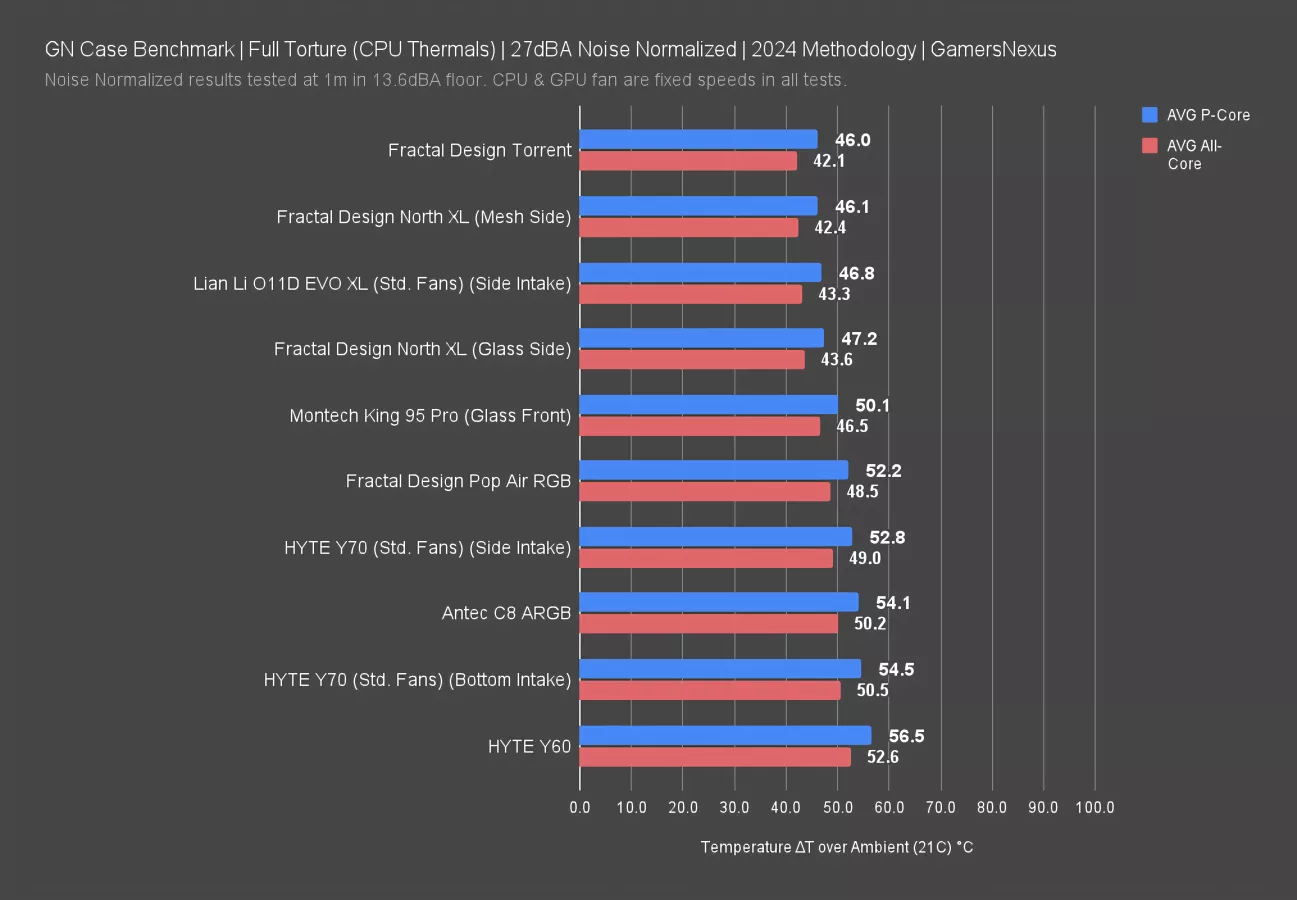
We'll start with noise-normalized testing. All case fans are dropped in tandem to reach our target of 27dBA at 1 meter in a noise floor of 13.6dBA. This puts all cases on an even playing field and balances out the advantages of cases that pack in as many loud fans as possible.
The Y70's noise-normalized CPU cooling performance is weak, partially due to the pressure loss at the panels. All that plastic is necessary reinforcement for the mesh, but also impedes flow.
The bottom intake configuration was already quieter, so it didn't require dropping fan speeds as much to reach the target, but the lack of direct airflow to the CPU cooler put the average core temperature at 51 degrees Celsius over ambient, and the P-Cores at 55 degrees. Side intake fared better at 49 degrees all-core and 53 degrees P-core. The Torrent tops the chart at 42 degrees all-core and 46 P-core, establishing a best of class target for performance.
Lian Li's O11 Dynamic EVO XL is directly comparable since it was tested with the same fans in like-for-like spots. The O11D Evo XL ran at 47 degrees for the P-core average, making it 6 degrees cooler than the Y70 with side intake because the O11 XL is guiding the airflow better. Antec's C8 tied the Y70's bottom-intake CPU thermals, which makes sense given the C8's bottom intake stock configuration although it does have different fans at 160mm. The C8 is worth paying attention to in the GPU thermals.
The Montech King 95 Pro improved about 3 degrees over the Y70 with side intake. That’s better, but not as much better as the six stock fans might lead you to expect. That’s the value of noise normalizing.
Finally, the Y60's average was worse than either of the Y70's tested configurations at 53 all-core and 57 P-core. The Y60 ships with stock fans in a bottom intake configuration, which puts it at a disadvantage for CPU thermals.
GPU Full Load Thermals (Full Speed)

This chart is for GPU thermals at full speed with the noise levels next to each entry name. It’s an interesting crossroads of thermals and noise.
Fractal’s Torrent is the best here for thermals, at 39 degrees GPU temperature and 42.3dBA for noise. The Y70 with side intake and our standard fans is better from a noise efficiency standpoint, though: It’s 2 degrees warmer (at 41C over ambient), but it’s also about 4dBA quieter. That’s a noticeable drop in noise for what’s likely an unnoticeable change in thermals but remember that these are fans we chose because the Y70 doesn’t include any.
The Antec C8 is better still, down at 37.1dBA and the same thermals as the Y70. This is a good showing for Antec’s more serious efforts in the case market this past year. Maybe we’ll do a standalone review for this one.
The Y70 with bottom intake is significantly quieter than the side intake configuration, dropping about 4dBA but also climbing for thermals. The noise reduction is due to a combination of the greater distance of the backmost fan and the loss of the side slat impact to acoustics. Interestingly, the O11D Evo XL (watch our review) is also about 34dBA, but with a side intake configuration. The thermals are the same, so this and the Y70 with bottom intake have equal noise and thermals in this test.
The Y60 was the quietest we’ve tested thus far -- that’ll change with time -- and it follows that it was also the warmest on this chart.
CPU Full Load Thermals - Standardized Fans
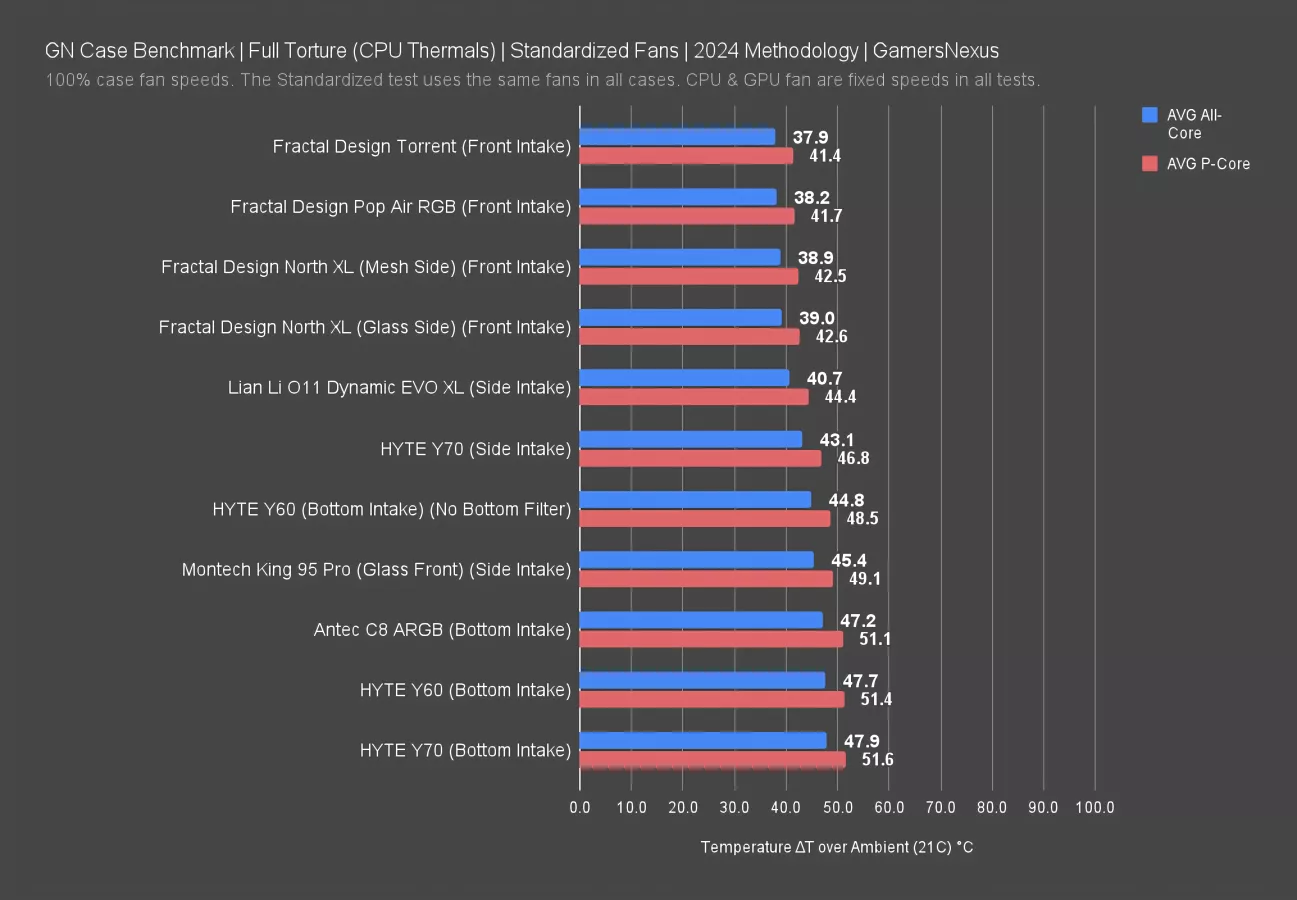
On this chart, the same standardized set of three Noctua fans (2x 140mm, 1x 120mm) is used in each case, and at max speed rather than noise normalized. That’s why the O11D EVO XL and Y70 results are different from the first chart despite using the same fans. The O11D EVO XL still beats the Y70, now by 2-3 degrees for side intake.
With the same fans in the same bottom-intake configuration, the Y70 and Y60 tied at 48 degrees Celsius above ambient for the average all-core CPU temperature and approximately 52 degrees P-core. Those are the warmest CPU results on this chart, tied with the Antec C8 with the same bottom intake configuration. This all makes sense: Forcing air past a GPU isn’t an effective way to cool a CPU. The Y60's bottom filter is more restrictive as well, but this should become more of a factor with GPU thermals.
GPU Full Load Thermals - Noise-Normalized
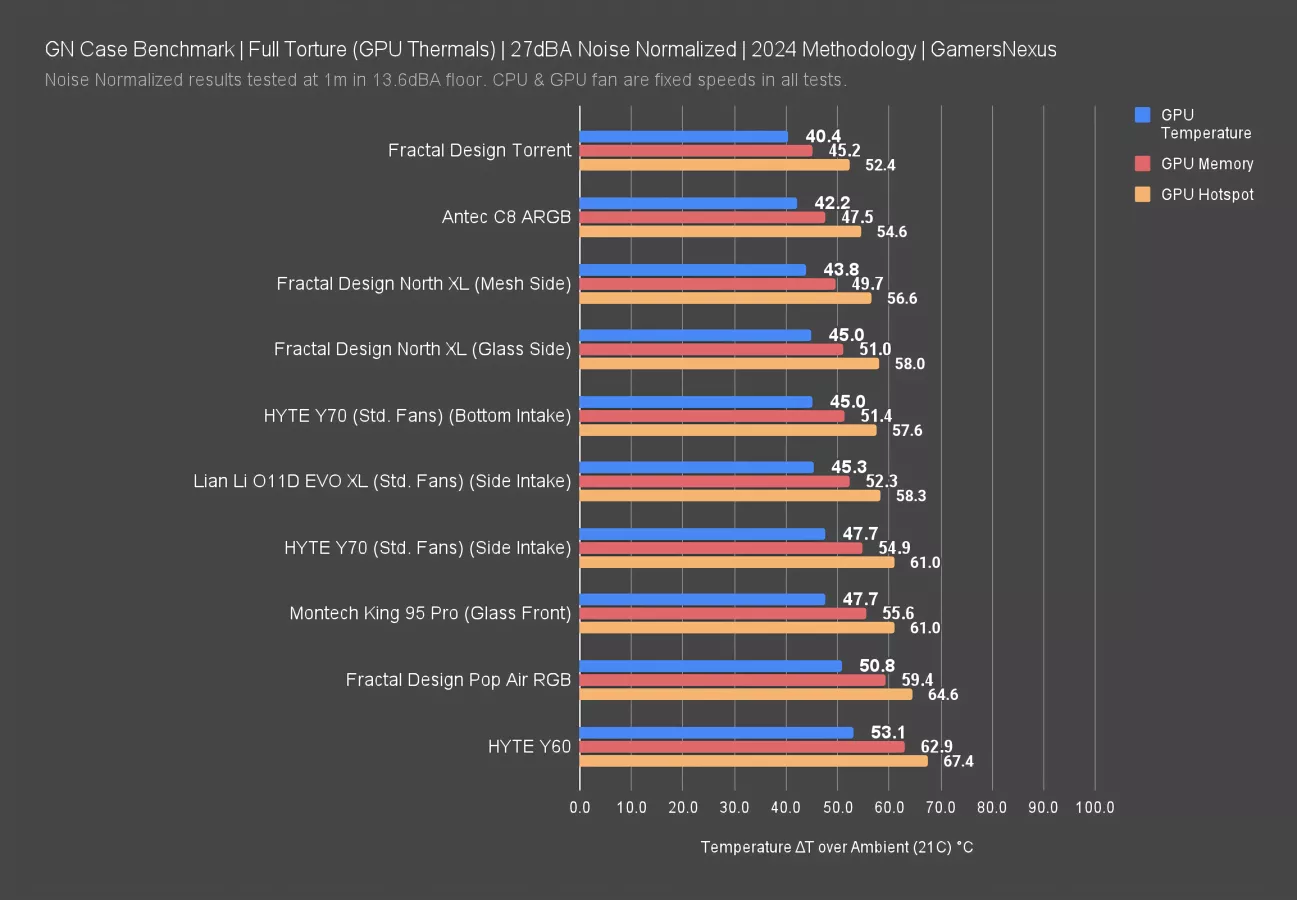
And here they are when noise normalized. The HYTE Y70 is more competitive when sorting by average GPU temperature. The Torrent establishes the best performance again, this time at 40 degrees Celsius over ambient for the average GPU temperature. That’s a great result. The Y70 side intake configuration averaged 48 degrees, which is a huge loss in performance versus the Torrent (watch our review). That’s a big range to establish. The bottom intake configuration with fans pointed directly into the GPU averaged 45, putting it in the middle of the chart.
The O11D EVO XL's average GPU temperatures with side intake are effectively tied with the Y70 bottom intake, so when taken together with the EVO XL's better CPU temperatures, the Lian Li case wins. The Antec C8 does extremely well here thanks to its aggressive focus on GPU cooling and its large fans in the bottom, landing at 42 degrees average. This is an excellent performance from Antec and borders on the Torrent. Where it’s weak in CPU, it’s strong in GPU.
The Y60 had the worst GPU thermals out of the limited set of data we've recorded so far, but it’s not awful. The GPU isn’t in throttling territory and still has plenty of room to breathe. It’s just the objective worst on the chart. We'll use the standardized fan chart again for a more direct comparison with the Y70.
GPU Full Load Thermals - Standardized Fans
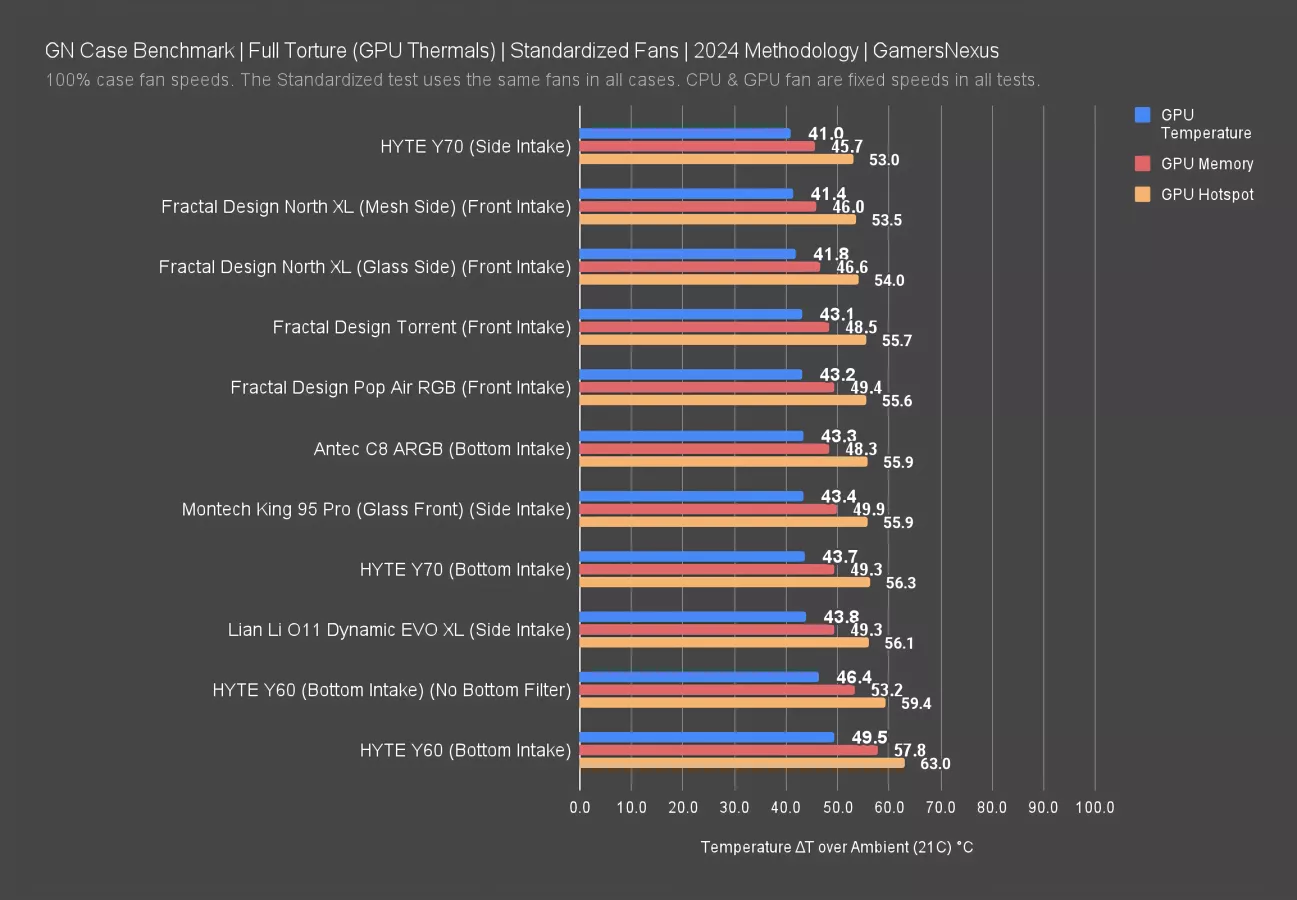
Moving to the full standardized fan chart, the Y70's side intake configuration is actually better than bottom intake for GPU thermals. Remember that side intake was also louder, so for the previous noise normalized chart, fan speeds were reduced more for the side intake result. On this chart, the standardized fans are set to 100%, which benefits the side intake configuration. This result is the best on the chart -- but standardizing the fans is a test our viewers requested, and we have a whole video detailing why this is a naturally flawed configuration. We run it due to popular demand. One of the reasons it’s flawed is that we’re removing fans that are naturally better in order to arbitrarily standardize: The Torrent has its excellent 180mm fans removed for this.
With enough airflow directed along the right path, the Y70 can hold its own, although the mesh-fronted cases have better overall performance when taking CPU thermals into account.
The Y60 was at the bottom of the chart here, but still acceptable for GPU thermals. Both of the Y-series cases have multiple layers of material around the bottom fan slots, and the Y60's bottom filter in particular is closed-off. Removing the bottom filter proves this, where we reduce the temperature by 3 degrees on the GPU. That’s huge for just removing a filter.
VRM & RAM Full Load Thermals - Noise-Normalized

For something different, here’s the VRM and RAM sensor thermals when noise normalized.
The VRM temperature in the Y70 averaged 35 degrees Celsius above ambient with bottom intake and 36 degrees with side intake. That's not much better than the Y60, which is currently the worst entry on the chart at 37 degrees. HYTE's competition did better, with the O11D EVO XL at 30 degrees and the King 95 Pro at 31. For comparison, the Fractal North XL is the current performance leader at 28 degrees.
There are two SPD hub sensors in our test bench, one for each stick of DRAM. The one we average is the one tucked underneath the CPU cooler, sheltered from direct airflow. The HYTE Y70 and Y60 are both still on the warm end of the chart here, with a best-case average of 27 degrees for the Y70 with bottom intake. This is one instance where the King 95 Pro's pile of fans helped, with an average of 21 degrees, while the O11D EVO XL only slightly beat the Y70 at 25 degrees.
HYTE Y70 Noise

One bonus set of data from the hemi-anechoic chamber: We noted an on-and-off quiet humming noise with the Y70 side intake configuration that pushed the average noise level up…somtimes. We think because of the closely-spaced slats on the Y70's side panel, this noise occasionally came up.
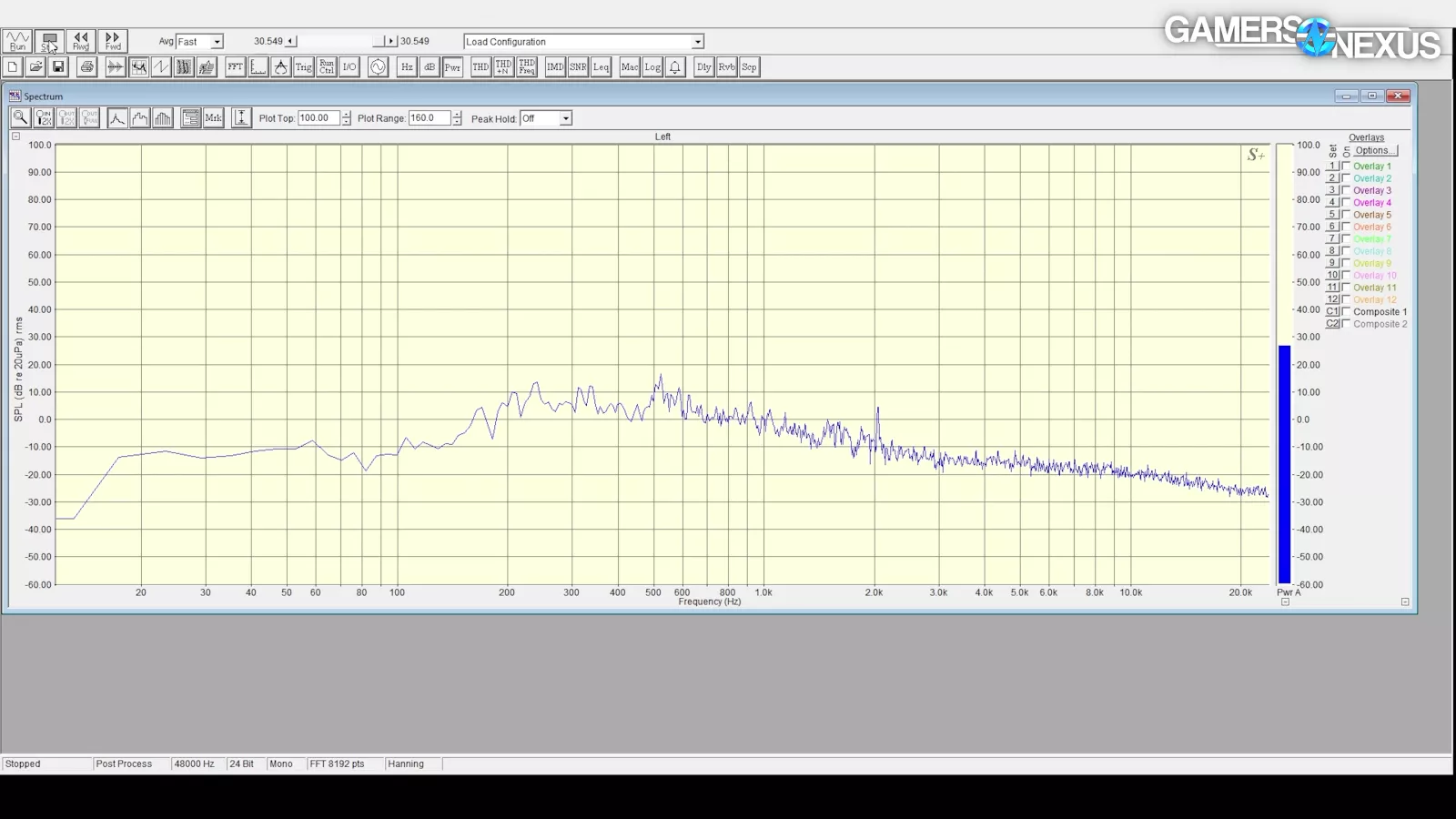
It’s not particularly loud, but it seems to happen as a result of the blade passing frequency over the slats. Overall, this is highly dependent on the fans you use but it's just another reminder that the slat or whole design and the panels can really affect the noise behavior.
HYTE Y70 Conclusion
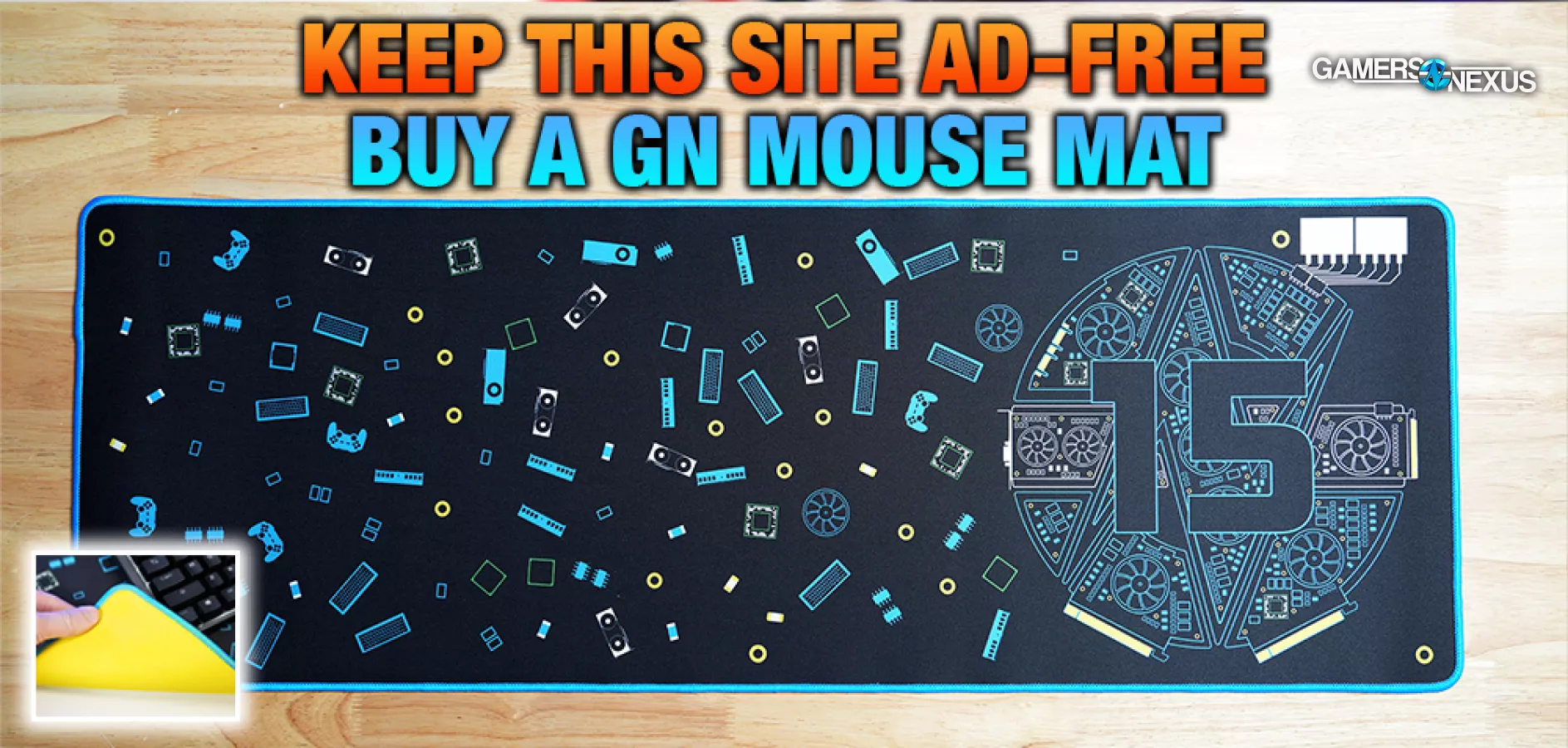
The Y70's biggest competition is the Y60. This isn't true for the Y70 Touch, since the Touch costs $360, while a Y60 and a Y60 LCD DIY Kit together cost $330 (and you still have to 3D print your own mounting hardware). Meanwhile, the plain Y70 at $220 has to compete with the plain Y60 at $180.
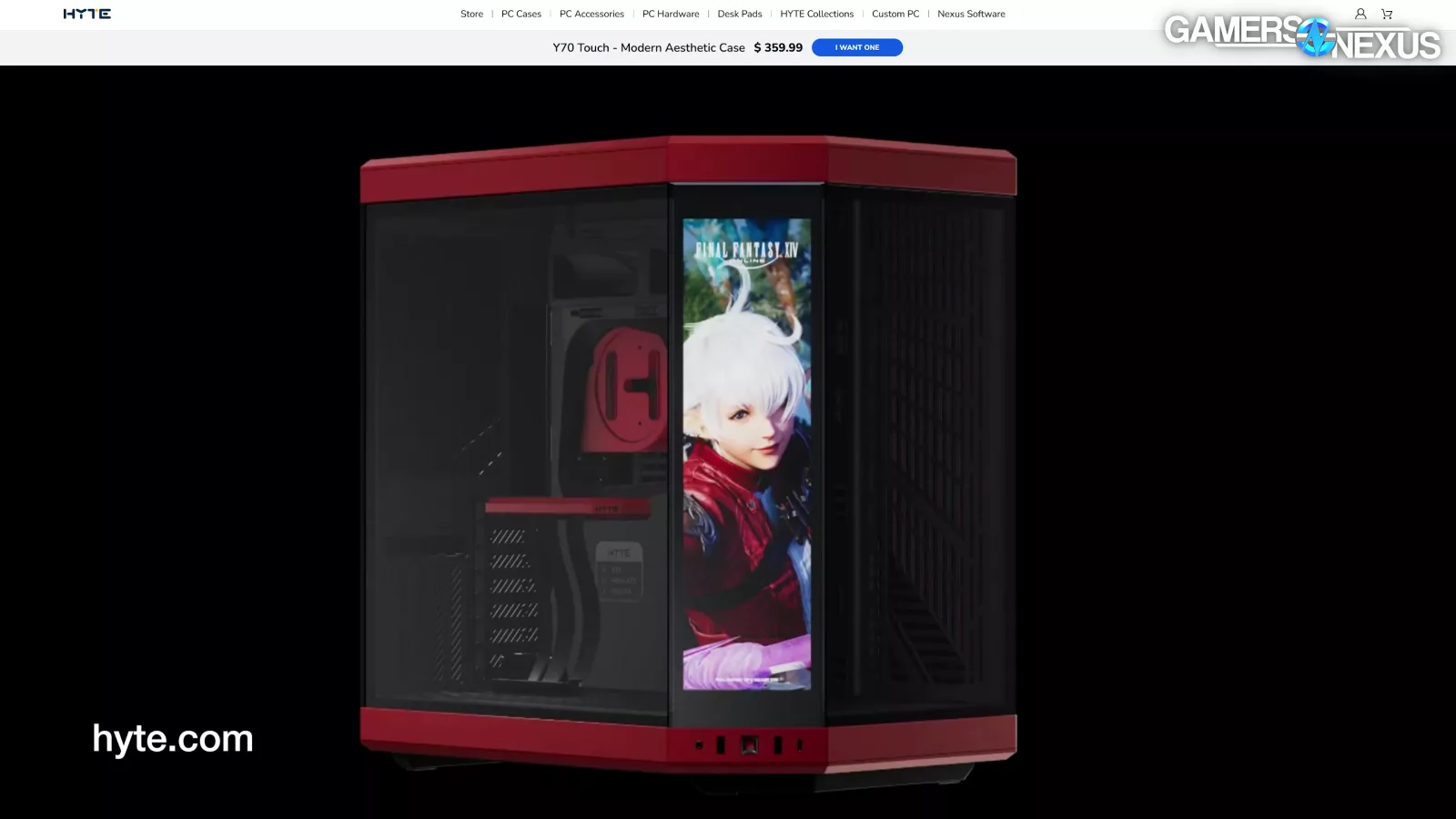
The situations in which a Y70 non-Touch makes more sense than a Y60 are very specific: you have a quad-slot GPU, or you have cooling hardware that won't fit in the Y60, or HYTE paints your favorite vtuber on the side of a Y70. HYTE has pitched the Y70 as a stopgap with the option to buy a Touch upgrade kit later, but we can't recommend doing that. Either buy something that exists now, or wait for the Y70 Touch to restock.

All of the Y-series cases compete based on appearance rather than performance, but that isn't necessarily a problem: the Y60 and Y70 Touch have both been extremely popular despite costing more than better-cooled cases. The triple tempered glass panels in the Y70 are best suited to a flashy liquid cooled system, which would make up for some of the thermal shortcomings. If you do need performance, the Lian Li O11D EVO XL fits into the same product category with potentially better airflow, much larger radiator capacity, and an invertible motherboard tray, while the Montech King 95 Pro and Antec C8 ARGB are both significantly cheaper and include full sets of case fans. Outside of dual-chamber cases, the Fractal Design Torrent remains at the top of our charts for air-cooled performance.
